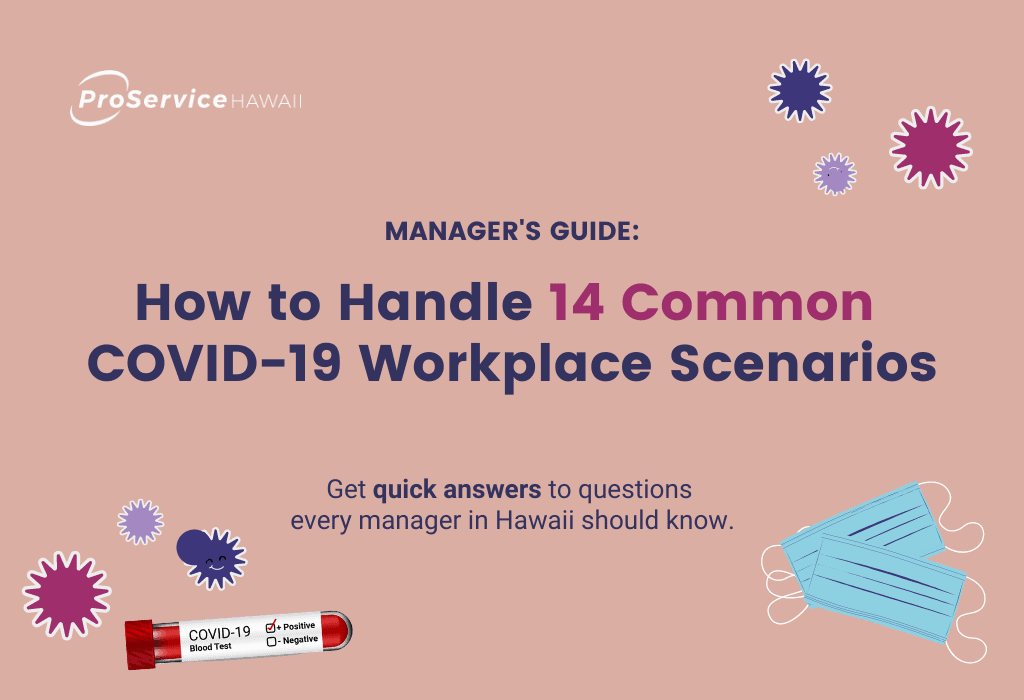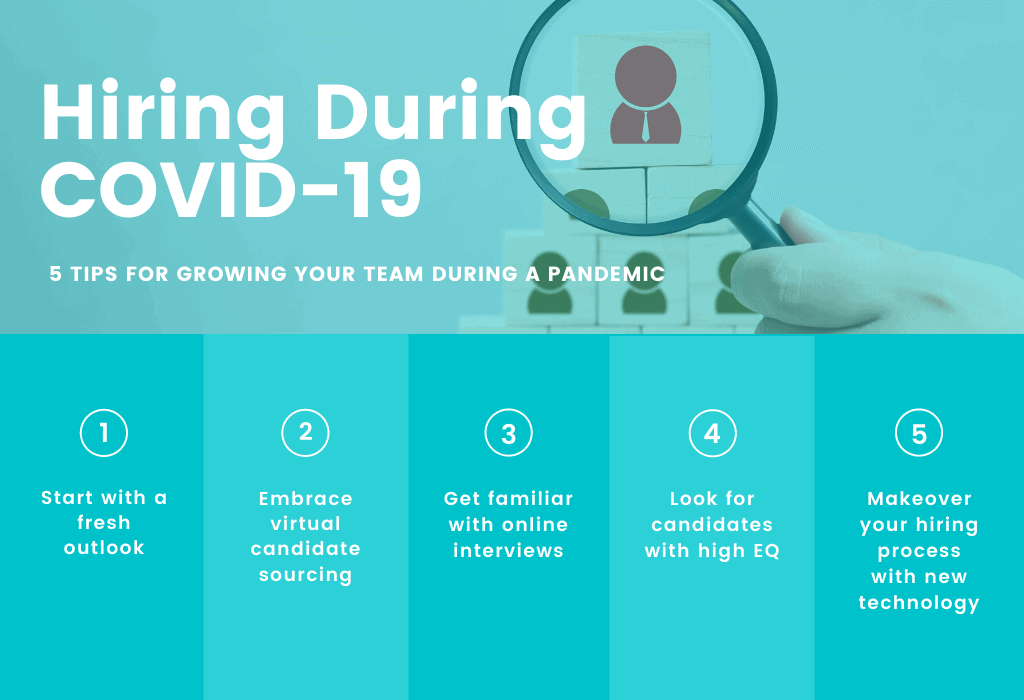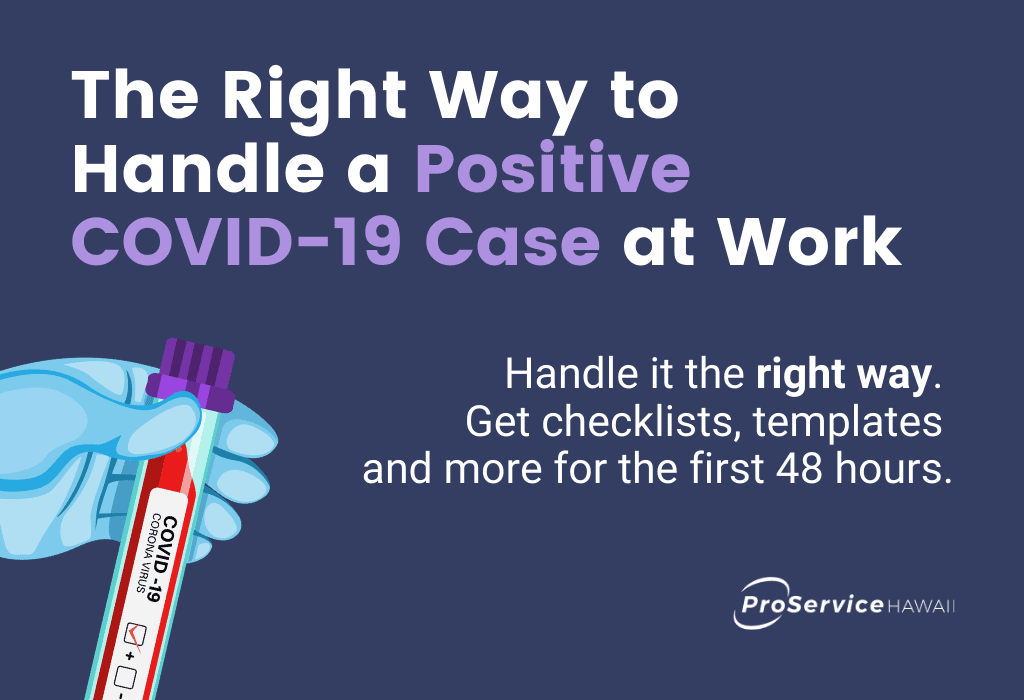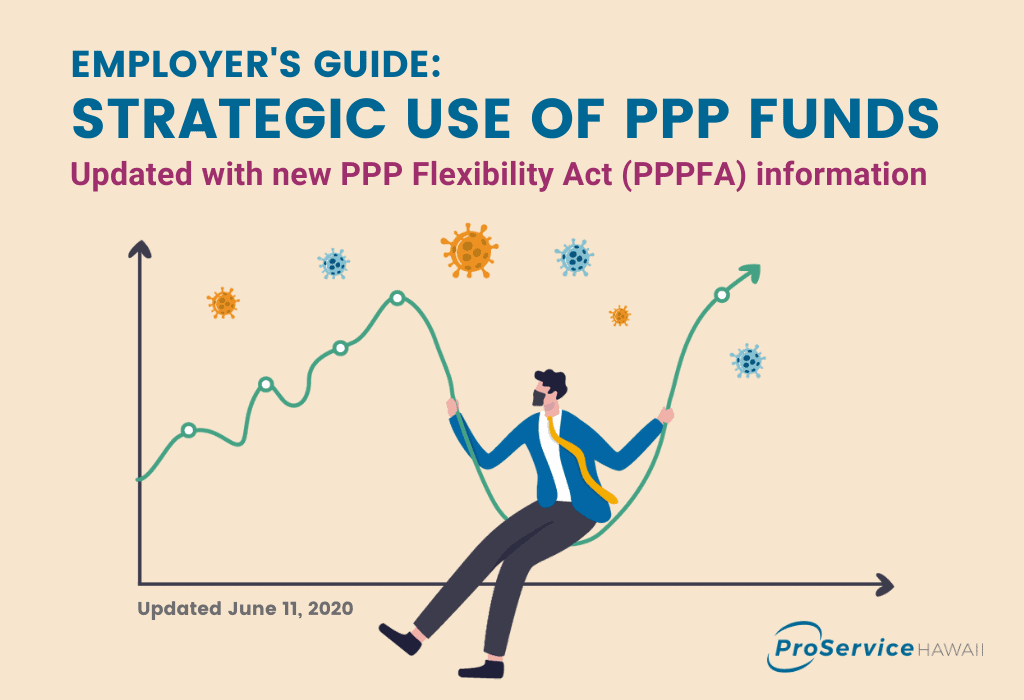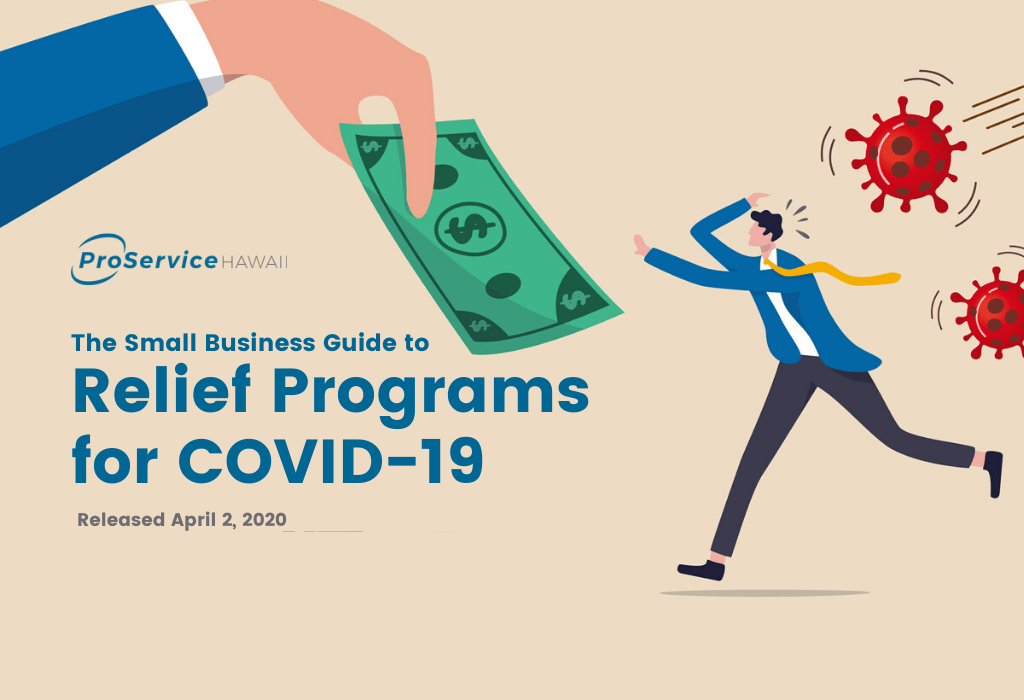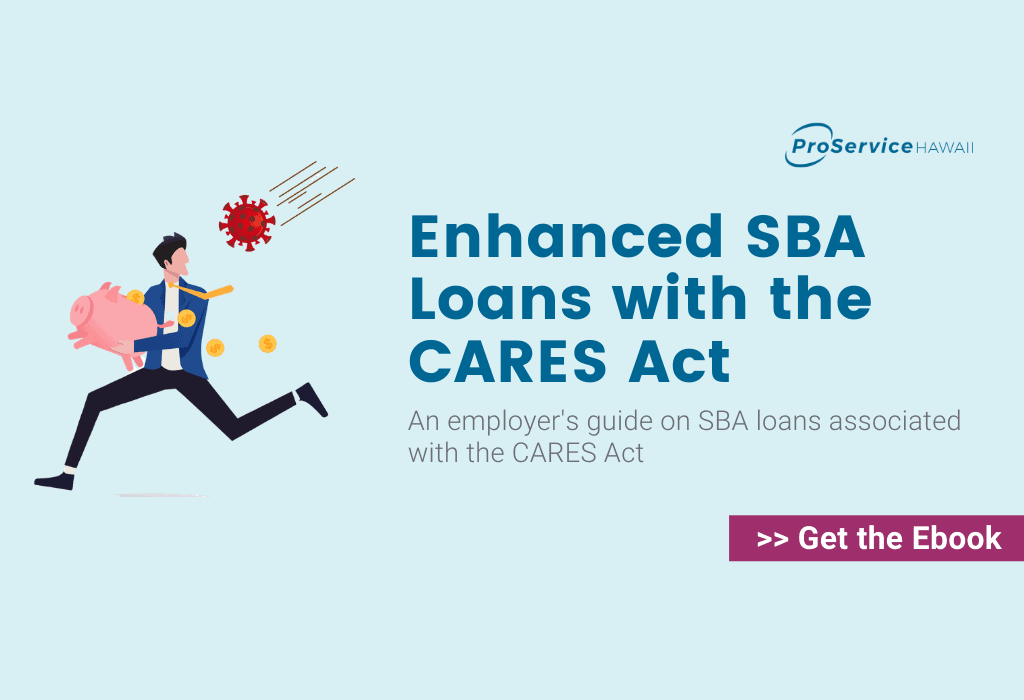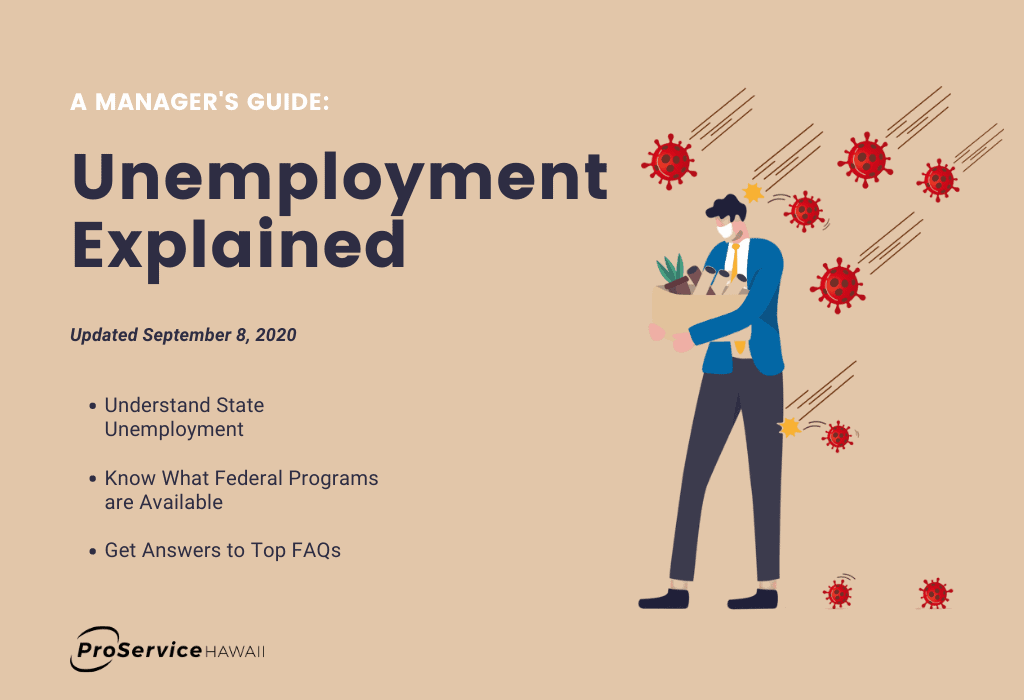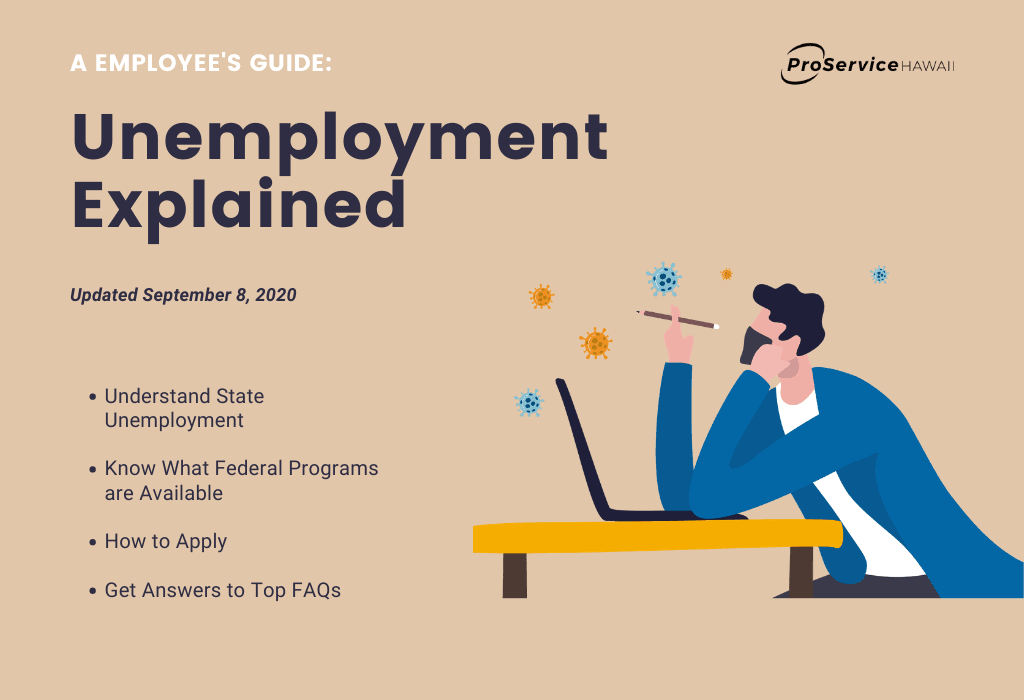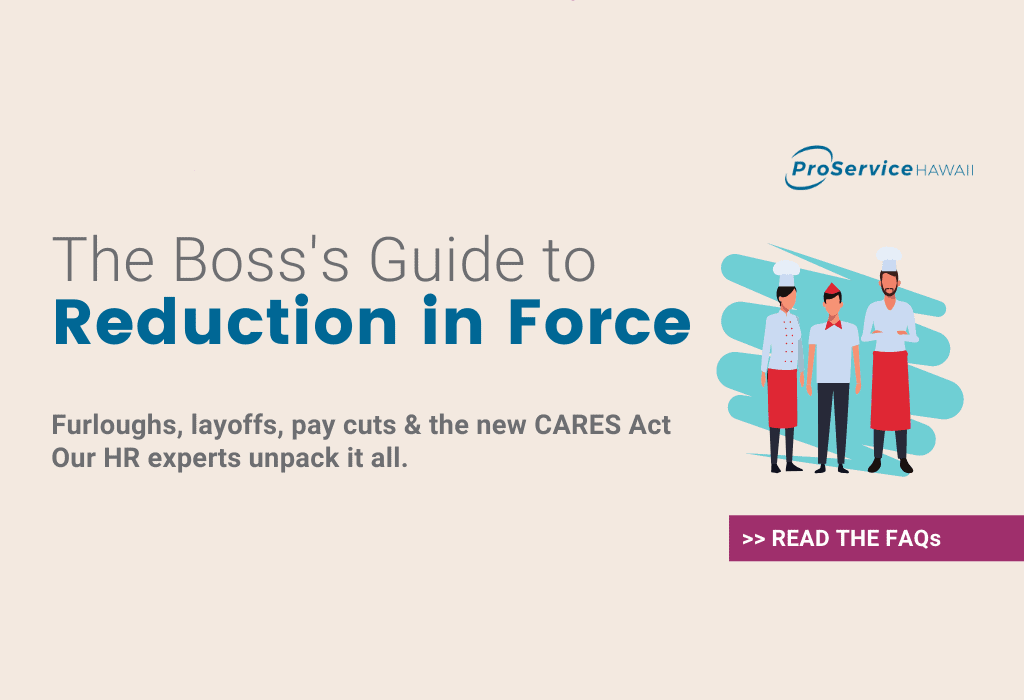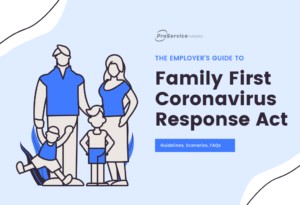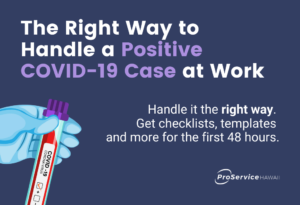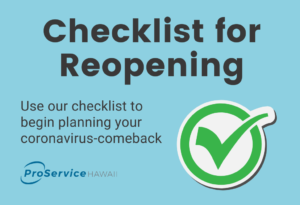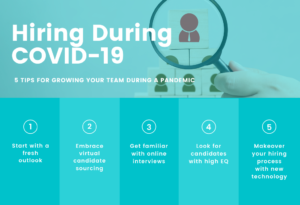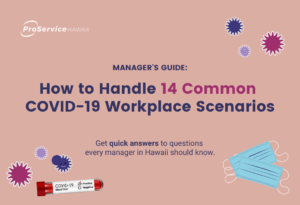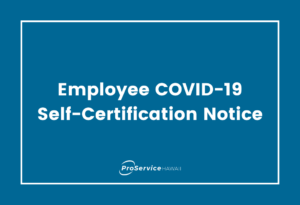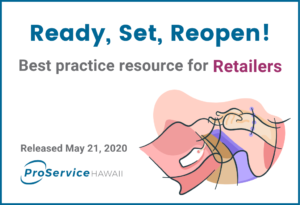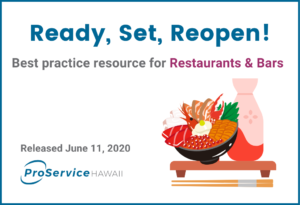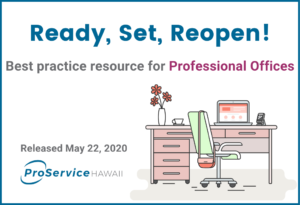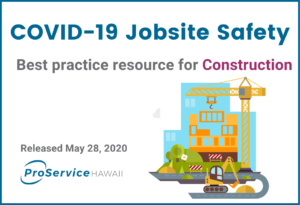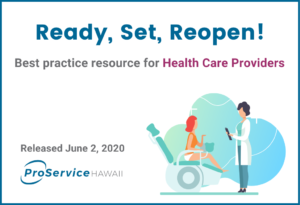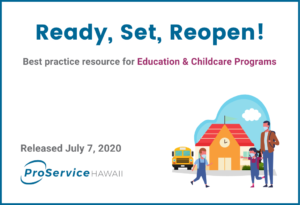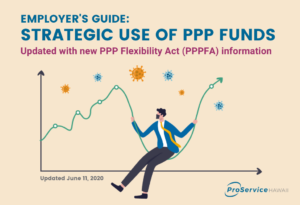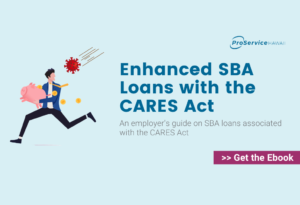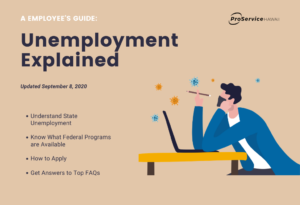Employer's Guide to Coronavirus
Thanks for checking out our Employer's Guide to Navigating COVID-19! We are no longer updating this page but if you need links to key resources, see below.
Key Local Links
- Information and Resources for Managing COVID-19, Hawaii Department of Health
- Information for Getting Your Vaccine or Booster, Hawaii Department of Health
Key National Links
- COVID-19 Guidance for Specific Settings, Centers for Disease Control and Prevention
- Vaccines for COVID-19, Centers for Disease Control and Prevention
Recent Updates
- Ben Godsey: Why We as Employers Need to Drive Vaccinations
- Guide: A Better Way to Reward Employees
- Ultimate Vaccine Resources
- The Ultimate Guide to Vaccines & the Workplace
- On-Demand: Hiring & Retaining in a Tight Labor Market
- On-Demand: Recoup Thousands with the Employee Retention Credit for 2020
- Ben Godsey: The Pendulum is Swinging the Other Way
- Update on FFCRA: New guide and request forms
- Status of COVID-19 Vaccines in Hawaii
- Ben Godsey: A Big Win for Hawaii & Our Recovery
- Recoup Thousands with the Employee Retention Credit for 2020
- Unlocking PPP 2.0 and the COVID Relief Stimulus
- What's in the $900 Billion COVID Relief Bill?
- Update from the Experts: PPP
- Maximizing Loan Forgiveness: Understanding the Flexibility Act
- PPP Loan Forgiveness
- Business Planning Webinar
- Families First Coronavirus Response Act
- Save Hawaii Businesses (A Panel Discussion)
- CARES Act: Navigating Laws, Loans, and Layoffs
- Talk Story with Ed Case & Ben Godsey
- Hiring & Retaining Workers in a Tight Labor Market
- Updates from the Experts: HR Practices and Policies for an Evolving Workforce
- Updates from the Experts: COVID-19 Workplace Scenarios
- What's Working? What's Not? What's Next For Your Favorite Restaurant?
- Reopening & Operating Your Educational Program
- Work in the New Normal: A Training for Healthcare Employees
- Operating Your Construction Company
- Reopening Your Professional Office
- Working in the New Normal: A Training for Employees
- Reopening & Operating Your Restaurant
- Reopening and Operating Your Retail Business
- Recipes for Reopening
- The New Normal: How to Make a Comeback
- Reopening Your Business to Survive & Thrive
- Remote Work
- Ergonomics
- Lead & Empower Your Team Through A Crisis
- Making Tough Decisions Amidst Uncertainty
- Five Fundamental Components of Resilient Leadership
- Adopting a Growth Mindset
- Women Rising & Leading Through Crisis
- What Hawaii Businesses Need. Right Now.
- The Here & Now on Employee Wellbeing
- Caring for Your People in the COVID Storm
- Deep Dive with Mark Mugiishi
- Retail CEO Roundtable
- Deep Dive with Bill Tobin
- Deep Dive with Rich Wacker
- Non-Profit CEO Roundtable
- Retail & Restaurant CEO Roundtable
Executive Series
Expert Interview:
Leadership In Crisis In Our Community
Our experts continue the conversation of leading in crisis in our community and, importantly, caring for employees. From what Hawaii needs to how people can support the community.
- John Fink, CEO of Aloha United Way
- Janina Abiles, Director of HR & Safety Training
Women Rising & Leading Through Crisis
Hear our panel of women leaders discuss a range of topics on leading effectively during times of turbulence and unprecedented change.
- Laura Beeman, University of Hawaii
- Miki Hardisty, ProService Hawaii
- Allison Izu, Allison Izu LLC
- Moderator: Trini Kaopuiki Clark, Make-A-Wish Hawaii
What Hawaii Businesses Need. Right Now.
Hear from a panel of Hawaii's most vocal business leaders discuss the critical needs of local businesses big and small
- Micah Kane, Hawaii Community Foundation
- Paul Kosasa, ABC Stores
- Monica Toguchi Ryan, Highway Inn
- Ben Godsey, ProService Hawaii
- Moderated by Bill Dorman, Hawaii Public Radio
The Here & Now on Employee Wellbeing
Get practical advice and best practices on how to engage your employees and help them manage stress.
- Beth Whitehead, American Savings Bank
- Jackie Ingamells, Global HR Consultant
- Moderated by Janina Abiles, ProService Hawaii
Caring for People in the COVID Storm
Hear experiences, lessons learned, and best practices from leaders operating on the front line of the COVID storm.
- Tricia Medeiros, The Plaza Assisted Living
- Donna Schmidt, Urgent Care Hawaii
- Dr. Emmanuel Kintu, Kalihi-Palama Health Center
- Michelle Kim Stone, ProService Hawaii
- Moderated by Janina Abiles, ProService Hawaii
Deep Dive with Mark Mugiishi
We sat down with Mark Mugiishi, President and CEO of HMSA—to dig a little deeper into a safe reopening from the public health lens.
Timestamps
[0:57] HMSA Response during the pandemic
[3:32] Increase in mental health needs and our kupuna
[5:32] Public health and reopening the state
[7:42] Working with health system partners
[8:32] A potential for a resurgence
[10:02] Masks for Hawaii: Protecting our Island State
[12:00] Contact tracing and Viral Testing
[15:35] Innovations in health care
[18:46] Concluding thoughts for small business owners
CEO Roundtable (Episode 3)
Listen to our CEO panelist discuss how they are quickly adapting their go-to-market strategy following the governor's latest announcement.
- Carol Ai May, Simply Organized, City Mill Company, Ltd.
- Tanna Dang, Eden in Love
- Tina Yamaki, Retail Merchants of Hawaii
- Michelle Kirk, ProService Hawaii
CEO Roundtable (Episode 2)
Hear from our CEO panel on how they're managing and motivating their workforce while evolving their service delivery model amidst times of intense pressure.
- Dean Wong, Imua Family Services
- Kim-Anh Nguyen, Blood Bank of Hawaii
- Micah Kane, Hawaii Community Foundation
- Ben Godsey, ProService Hawaii
CEO Roundtable (Episode 1)
With PPP loans funding, all employers are deciding how best to use these funds. Hear two approaches from our CEO panel on how they're using their funds.
- Ed Schultz, Hawaiian Host
- Ed Sultan, Na Hoku
- Bill Tobin, Tiki's Bar & Grill
- Ben Godsey, ProService Hawaii
[1:10-2:30] Welcome Introductions
[3:25-9:18] The State of Business
[9:19-20:30] Immediate Priorities and Next Steps
[21:49-30:03] PPP Loan: Different Thoughts & Approaches to Funding
[30:10-32:33] Tips for Working with Your Team
[32:37-50:00] Planning for Re-Opening
[50:00-53:13] Q&A – What can businesses do if they’re dependent on tourism?
[53:16-56:25 ]Q&A – The role of retail & restaurant dialogue with state decision-makers?
[56:30-59:58] Q&A – How do you think reduced capacity from social distancing will impact overall volume in restaurants?
[1:00:00] Conclusion: We’re just beginning the reset for what the economy will look like next.
Coronavirus Basics
Find info on coronavirus and learn how to protect yourself and others
from spreading the virus.
Coronavirus (COVID-19) is a respiratory illness that can spread from person to person, according to the Center for Disease Control (CDC). The virus that causes COVID-19 is a novel coronavirus that was first identified during an investigation into an outbreak in Wuhan, China.
Resources:
- Preventing COVID-19 from spreading (CDC)
- Daily COVID-19 Updates (Hawaii Department of Health)
The most common symptoms of COVID-19 are: Fever, tiredness, dry cough. Some people may also have aches and pains, nasal congestion, runny nose, sore throat or diarrhea. These symptoms are usually mild and begin gradually.
Some people become infected but don’t develop any symptoms and don't feel unwell. As many as 25% of people infected with the new coronavirus may not show symptoms, the director of the Centers for Disease Control and Prevention warns,
Most people (about 80%) recover from the disease without needing special treatment. Around 1 out of every 6 people who gets COVID-19 becomes seriously ill and develops difficulty breathing. Older people, and those with underlying medical problems like high blood pressure, heart problems or diabetes, are more likely to develop serious illness. People with fever, cough and difficulty breathing should seek medical attention.
Resources:
- Symptoms of Coronavirus (CDC)
- People who are at higher risk for severe illness (CDC)
- More evidence indicates healthy people can spread coronavirus (Associated Press)
- Infected but feeling fine: The unwitting coronavirus spreaders (New York Times)
Update as of 5/18: Governor Ige announced the change of his previous “Safer At Home” order to “Act with Care” order as part of the his Eighth Supplementary Proclamation. Social distancing rules and safe practices must still be followed. The 14-day travel quarantine remains in place until the end of June.
Safety Signage Requirement for Businesses: Pursuant to the Governor’s proclamation on April 16, 2020, all essential businesses are required to post a notice on their doors for all employees and visitors. Here’s a poster you can use.
Resources:
- Mayor Caldwell's updated Emergency Order (7/7)
- Video of Governor Ige announcing “Act with Care” phase (5/18)
- Governor's Eighth Supplementary Proclamation, signed 5/18 (Office of Govenor Ige)
- COVID-19 Essential Business Health & Safety Poster (ProService Hawaii)
- View the latest covid counts in Hawaii (Hawaii Data Collaborative)
- List of ‘essential workers' (ProService Hawaii)
Governors across the nation are taking stronger action by issuing stay-at-home orders in their states. Stay-at-home requires people to stay inside as much as possible and only go out for necessary activities. Exceptions to the order are being made for essential work and services, grocery shopping, medical care and exercise (as long as strict social distancing guidelines are followed).
Update on 9/8: Honolulu Mayor Caldwell extended Oahu’s second Stay-at-Home order which began on August 27 through September 23. With this extension, parks and beaches will reopen but only for individual (solo) activities. Non-essential businesses will continue to be closed, restaurants can only offer takeout, and social activities of any type will continue to be banned. Read the FAQ’s for more information on permitted activities, essential and non-essential businesses, and more.
Resources:
Resources:
Oahu’s stay-at-home orders have begun and many businesses must once again navigate a closed economy to curb the spread of COVID-19.
As always, we’re here to help. As you pivot to respond and adjust, here’s a few topical pointers to keep in mind as you head into the next two weeks.
- Remind employees about unemployment. If you're reducing employees’ hours or putting them on furloughs, remind your employees they may be eligible for unemployment benefits. Share this link and remind them to re-certify each week. >> Share the Link
- Know when FFCRA applies. Amidst Oahu’s shutdown, new surge testing, and back-to-school season, knowing when employees are entitled to FFCRA paid sick leave or child care leave (and when they’re not) will be critical. >> Learn More
- You should not force employees to submit to COVID-19 testing, unless you’re in the healthcare industry or work with a vulnerable population. Instead, do your best to be flexible so that your employees can balance their children, families, and voluntary participation in surge testing. >> Get Guide
- Lastly, remember remote work best practices. Whether you’re thrilled to work from home or dreading it, remote work is our new reality for two weeks, so we need to make the best of it. Set-up your workplace, establish hours/breaks/boundaries, and don’t forget to get up and move. >>Get More Best Practices
We hope you find this helpful, we’ll share more shut-down survival tips throughout the next two weeks.
The best way to prevent illness is to avoid being exposed to the coronavirus. That’s why government officials are recommending that everyone practice social distancing measures at this time. Even if you are young, or otherwise healthy, you are still at risk and your activities can increase the risk for others. It is critical that we all do our part to slow the spread of the coronavirus:
- Work or engage in schooling from home whenever possible.
- Avoid social gatherings in groups of more than 10 people.
- Use drive-thru, pickup, take out or delivery options for food and grocery items.
- Avoid discretionary travel, shopping trips, and social visits.
- Do not visit nursing homes or retirement or long-term care facilities unless to provide critical assistance.
- Drop off food to family or loved ones, but do not gather socially
- Practice good hygiene by washing your hands, especially after touching any frequently used item or surface.
- Avoid touching your face.
- Sneeze or cough into a tissue, or the inside of your elbow.
- Disinfect frequently used items and surfaces as much as possible.
- Donate excess toilet paper, hand sanitizers or masks to essential businesses or healthcare facilities
Per CDC guidance, older adults and people who have severe underlying chronic medical conditions like heart or lung disease or diabetes seem to be at higher risk for developing more serious complications from COVID-19 illness. They should consult with their health care provider about additional steps they may be able to take to protect themselves.
Resources:
Health & Safety at Work
Learn how to handle employee travel, testing and how to prevent the spread
of coronavirus in your workplace.
Prevent the Spread
Employer Question:
I’ve been told that an employee socializes with his friends at restaurants frequently. His coworkers are concerned that he is not following social distancing and face covering practices. What can we do to ensure the employee is following social distancing and face covering practices when he is not at the office so that he does not bring COVID-19 into the workplace
Answer:
An employee’s off-duty conduct is generally off-limits for an employer to monitor or regulate unless there’s a reasonable relationship between an employee’s off-duty conduct and the employer’s business. In other words, the employer would have to show that the employee’s off-duty contact poses a direct risk to the employer’s business. In the above scenario, however, employers should be careful about assuming an employee is not following social distancing and face covering practices just because the employee eats at restaurants and should instead rely on daily self-certifications by the employee that he or she has not had close contact with someone testing positive for COVID-19 or is waiting for a test result, is not personally exhibiting any COVID-19 symptoms and is following all of the employer’s policies on social distancing, face covering, personal hygiene and cleaning and disinfecting while in the workplace.
If an employer learns of more specific information that an employee is not following social distancing and face covering practices off-duty, particularly if the employee works with high-risk individuals, given the current pandemic and that social distancing and face covering wearing is required under current state and county orders, an employer could ask the employee to quarantine at home for 14 days. Know, however, that if an employee’s health care provider is not the one advising the employee to self-quarantine, the employee will not qualify for FFCRA paid sick leave and the employer may have to pay for a portion of that time if the employee is exempt/salaried and already worked a portion of the work week before being ordered to quarantine for 14 days. Employers should also be sure to be consistent when asking employees to quarantine at home for 14 days to avoid any potential discrimination claims by employees.
Finally, even if employers are allowed to monitor an employee’s off-duty contact due to COVID-19 exposure/close contact concerns, it does not mean employers should do so. It could be difficult to consistently apply this practice and sending employees home for 14 days every time a concern is raised might create staffing and production issues for the employer. Also, employers could suffer unintended consequences such as low employee morale.
On Oahu, face coverings while indoors (commercial and residential buildings) is mandatory at all times, especially when engaging and interacting with customers, visitors or other employees. If the company’s policy is also to require face coverings to be worn indoors at all times if social distancing is not attainable, employers should repeat and enforce their face covering policy and discipline their employees accordingly for violating company policy and current county or state orders.
There are certain limited situations that an employee may be exempt from wearing a face covering indoors. If the employee has a recognized disability or has religious reasons for not wearing a face covering they may be exempt from the face covering requirement. Even then, however, the employee does not have an automatic exemption. Employers must discuss with the employee to see if there are any alternate and reasonable accommodations to wearing a face covering that will suffice to protect the employers and others.
As a private business owner, you can require customers or visitors to wear a face covering while on your property. We recommend taking the following steps to minimize disruption to your business by an anti-mask guest or confrontation with such a guest.
First, overly-promote your face covering policy. More awareness of your face covering policy may lessen customer and guests’ confusion of whether or not they must wear a face covering when visiting your business. Make your face covering policy signage abundant at entrances to your business. Post your policy on all of your social media channels to further notify your customers and guests. If you are confirming over email or text a meal reservation or order or a product that is ready for pick up to a customer, include in that email or text a reminder that face coverings are required when visiting your business.
Next, train all of your employees on all health and safety measures you are implementing at the workplace, including the face covering requirement. Your employees are more likely to better communicate the face covering policy to customers and visitors if they understand the health reasons behind the requirements. Also critical for your employees is training on how to politely request customers to wear a face covering. You may even want to consider providing disposable face coverings to customers. Sometimes customers may have simply forgotten to grab a covering so rather than the customer being irritated that he or she has to return home or to the car to grab a covering, by offering a free face covering to a customer you have diffused a potentially uncomfortable situation.
Finally, assign the right employee to communicate your face covering policy to customers and visitors entering your workplace. The best employee is one with a calm, patient and easy-going yet professional demeanor. For their own safety, employees should not argue with customers refusing to wear a mask or physically block customers from entering the premises and instead should know when to escalate the situation to a manager or security or law enforcement (if they feel physically threatened by a customer). Also, under the current county orders, individuals who cannot wear a face covering due to medical conditions or disabilities where the wearing of a face covering may pose a health or safety risk to the person are encouraged to wear a face shield instead. So for any customer claiming they are medically prevented from wearing a face covering, the designated employee should be comfortable with encouraging the customer to return wearing a face shield, or offering your other alternate services you have in place as an option, such as curbside service or online shopping and mail delivery.
1. Assess your employees’ exposure to risk
OSHA has divided workplaces and work operations into four risk zones, according to the likelihood of employees’ occupational exposure during a pandemic. These risk zones are useful in determining appropriate work practices and precautions.
- Very High Exposure Risk: Healthcare employees performing aerosol-generating procedures on known or suspected pandemic patients; Healthcare or laboratory personnel collecting or handling specimens from known or suspected pandemic patients.
- High Exposure Risk: Healthcare delivery and support staff exposed to known or suspected pandemic patients; Medical transport of known or suspected pandemic patients in enclosed vehicles.; Performing autopsies on known or suspected pandemic patients.
- Medium Exposure Risk: Employees with high-frequency contact with the general population (such as schools, high population density work environments, and some high-volume retail).
- Lower Exposure Risk (Caution): Employees who have minimal occupational contact with the general public and other coworkers (such as office employees)
Generally, you can assess your employees’ exposure to health risks by answering the following questions about their duties:
- Do employees have face-to-face contact with large numbers of people?
- Do employees spend time in work sites, like health care settings, where they may come into contact with ill people?
- Do employees handle materials that could be contaminated, like laboratory samples or healthcare waste?
Resources:
- Guidance on preparing workplaces for COVID-19 (OSHA)
- Hazard Recognition (OSHA)
- COVID-19 Standards (OSHA)
- Control and Prevention (OSHA)
2. Tell sick employees to stay home
Employees who report having a fever or an acute respiratory illness upon arrival to work or who become sick during the work day should be separated from others and immediately sent home. They should be fever free (100.4° F or below) for 72 hours without the use of fever-reducing or symptom-altering medicines before returning to work.
Consider the following:
- Communicate your policies to all managers and employees with the expectation that sick employees stay home.
- If possible, designate a separate area at your work site where sick employees can temporarily isolate. Use this space for those who become ill during the work day and are awaiting transportation to their home or to medical care.
- Do not wait for employees to provide a healthcare provider’s note to validate illness or to return to work if they are sick with acute respiratory illness. Many medical offices and facilities may be extremely busy and may not be able to accommodate within a timely manner.
Resources:
3. Implement Infection Control
- Place posters that encourage staying home when sick, cough and sneeze etiquette, and hand hygiene at the entrances to your workplace, in restrooms, and in high visibility locations.
- Remind employees to clean hands often with an alcohol-based hand sanitizer (60-95% alcohol based) or by washing for at least 20 seconds (two rounds of the “Happy Birthday” song).
- Provide tissues and no-touch disposal receptacles.
- Routinely clean and sanitize hands after visiting high-traffic areas like conference rooms or break rooms but also doorknobs, keyboards, remote controls, desks etc.
Resources:
- Stop the spread of Germs (CDC)
4. Follow strict social distancing guidelines
Social distancing is an intervention to increase the physical distance between people and reduce the spread of disease. Economists point out that social distancing is not only saving lives, but also protecting the much-needed workforce from being depleted due to unnecessary illnesses and deaths.
We want to take this opportunity to make ProService Hawaii’s position clear: social distancing is crucial to the survival of hundreds of thousands of people.
Here’s what you can do:
- Maintain a distance of +6 feet from others
- Stay out of crowded places
- Work from home if possible
- Avoid contact with people at higher risk for severe illness
- Stay home and isolate for 14 days after any travel
Pursuant to the Governor’s proclamation on April 16, 2020, all essential businesses are required to post a notice on their doors for all employees and visitors. Here’s a poster you can use.
Resources:
- COVID-19 Essential Business Health & Safety Poster (ProService Hawaii)
- Economic shutdown is estimated to save 600,000 American lives (Bloomberg)
- Coronavirus, Social and Physical Distancing and Self-Quarantine (John Hopkins Medicine)
Good news! The State has begun to ramp up vaccinations to qualified individuals in Phase 1C. People aged 65+ or with high-risk medical conditions are also eligible to receive the vaccine.
Due to high demand, Phase 1C essential workers have been updated to only include:
- Hotel and hospitality workers
- Foodservice workers
Employees in industries like housing, construction and communications that were on the initial priority list are excluded for now.
To learn more or get the latest about the state's plan, visit https://hawaiicovid19.com/vaccine.
Employee Travel
The general answer is yes if the employee is not in a “high-risk” category and there has not been a positive case in the workplace. Under the ADA, however, employers may have to make certain reasonable exceptions or accommodations, such as teleworking or leave, if the employee has a high risk of serious health complications related to COVID-19.
In addition, in certain limited situations, OSHA permits an employee to refuse to work or perform a specific task. Under OSHA’s general duty clause, employers must maintain a safe workplace and mitigate any health or safety hazards. Therefore, in the limited situation of a positive case in the workplace and actual exposure to a coworker testing positive for COVID-19, an employee could refuse to work if ALL of the following conditions are met:
- the employee asked the employer to eliminate the hazard and the employer failed to do so;
- the employee genuinely believes that an imminent danger exists;
- a reasonable person would agree with the employee that there is a real danger of death or serious injury; and
- the urgency of the hazard does not allow correction through OSHA’s regular enforcement channels, such as requesting an OSHA inspection.
Updated August 14, 2020:
In a nutshell, no. The novel coronavirus has spread to more than 100 countries and nearly every continent.
At this time, any person (visitor and resident) coming into Hawaii must undergo a 14-day quarantine upon arrival. If your employee is subject to this mandatory 14-day quarantine, your employee may be eligible for FFCRA paid sick leave if that employee is unable to work from home during this quarantine period.
Governor Ige also reinstated partial interisland quarantine as of August 11. Under this ruling, anyone traveling within Hawaii from one island to another, with the exception of those arriving on Oahu, will need to quarantine for 14 days.
For Business Travel
Employers should limit all business travel, especially to affected areas at this time, and provide reasonable accommodations such as video conferencing during the duration of the threat and heightened risk.
You should also monitor travel alerts from the U.S. State Department to seek objective guidance about the health risks posed by travel to specific areas.
For Personal Travel
You can’t force an employee to cancel their personal travel, but you can encourage them to visit the CDC’s Traveler’s Health Site to get the latest guidance and recommendations for those who intend on traveling.
Upon their return, advise employees to check themselves for symptoms and tell their manager immediately if they start to have symptoms. Promptly call a healthcare provider for assistance if needed.
Resources:
- Partial interisland quarantine reinstated 8/11 (KHON2)
- Travel advisories (State of Hawaii Department of Health)
- Traveler’s health (CDC)
- FAQs for travelers (CDC)
As of August 11, 2020, any person (visitor and resident) coming into Hawaii must undergo a 14-day quarantine upon arrival. If your employee recently traveled and is subject to this mandatory 14-day quarantine, your employee may be eligible for FFCRA paid sick leave if that employee is unable to work from home during this quarantine period.
Quarantine and Testing
Employer Question:
When can we require employees to get tested for COVID-19 and show proof of a negative test result before returning to work? Do we have to pay for the test? Do we have to pay the employees for the time it takes to get the test and wait for a negative result before they return to work
Answer:
Unless an employee exhibits any symptoms of COVID-19 or tells you that they have had close contact with someone testing positive for COVID-19, we do not recommend requiring your employees to get tested and show proof of a negative test result before returning to work. Both the Centers for Disease Control and Prevention (CDC) and the U.S. Department of Labor (US DOL) recognizes that requiring documentation or proof of a negative test may put an unnecessary burden on healthcare providers and resources during a pandemic, which makes it difficult for employees to get appointments. This in turn can lead to unnecessary delays when an employee is actually able to work.
Moreover, under the FFCRA, health care carriers will cover the cost of COVID-19 tests only if they are medically necessary. This means that if an employee’s healthcare provider does not order a test but employers require the test as a condition to work, the employer must likely pay for the test. This also means that the time that an employee awaits the tests results is not covered under FFCRA paid sick leave (because the test was not deemed medically necessary) therefore if the employee is an exempt/salaried employee, the employer may also have to pay the employee for the time it takes for the employee to get the test and wait for the results. (Employers do not have to pay non-exempt/hourly employees for any time if that employee did not perform any work).
Employer Question:
My employee traveled to the mainland and is currently quarantining at home for 14 days. We work with young children so want to be as safe as possible. Can I require my employee to get a COVID-19 test and provide proof of a negative result before returning to work?
Answer:
The same answer in the previous question applies to this situation. In addition, if your employee is taking FFCRA paid sick leave to cover his or her 14-day quarantine period and you still want to require a COVID-19 test, you must require all employees returning from leave to take a COVID-19 test, not just those returning from FFCRA paid sick leave. If you require a COVID-19 test for only employees returning from FFCRA paid sick leave, this could be interpreted as disciplining or otherwise discriminating against an employee who took FFCRA paid sick leave.
Employer Question:
My employee informed me that she has family members incoming from the West Coast and will be quarantining for 14-days with her. Does my employee also have to quarantine for 14-days
Answer:
Unless your employee’s family members or your employee begins to show any symptoms of COVID-19 during the family members’ quarantine period, your employee does not have to quarantine for 14 days.
Yes. While taking an employee’s temperature is a medical examination under the American Disabilities Act, given the community spread of COVID-19, employers may take an employee’s temperature. However, as a practical matter, an employee may have COVID-19 without having a fever so temperature checks alone are not the most effective preventative measures.
Updated 3/30/20:
You should send home employees who have tested positive, as well as any employees who’ve worked closely with that employee, for a 14-day period of time to ensure the infection does not spread. Essential workers can return to work if they self-monitor as follows:
Do – Take your temperature before work, wear a face mask at all times & practice social distancing in the workplace as work duties permit
Don't – Stay at work if you become sick, share objects used near face or congregate in break rooms or other crowed work spaces.
Before the employee departs, ask them to identify all individuals who worked in close proximity (three to six feet) with them in the previous 14 days to ensure you have a full list of those who should be sent home. When sending the employees home, do not identify by name the infected employee or you could risk a violation of confidentiality laws. If you work in a shared office building or area, you should inform building management so they can take whatever precautions they deem necessary.
The CDC also provides the following recommendations for most non-healthcare businesses that have suspected or confirmed COVID-19 cases:
- Close off areas used by the ill persons and wait as long as practical before beginning cleaning and disinfection to minimize potential for exposure to respiratory droplets. Open outside doors and windows to increase air circulation in the area. If possible, wait up to 24 hours before beginning cleaning and disinfection.
- Cleaning staff should clean and disinfect all areas (e.g., offices, bathrooms, and common areas) used by the ill persons, focusing especially on frequently touched surfaces.
- Employers should develop policies for worker protection and provide training to all cleaning staff on site prior to providing cleaning tasks. Training should include when to use PPE, what PPE is necessary, how to properly don (put on), use, and doff (take off) PPE, and how to properly dispose of PPE.
If employers are using cleaners other than household cleaners with more frequency than an employee would use at home, employers must also ensure workers are trained on the hazards of the cleaning chemicals used in the workplace and maintain a written program in accordance with OSHA’s Hazard Communication standard.
Simply download the manufacturer’s Safety Data Sheet (SDS) and share with employees as needed, and make sure the cleaners used are on your list of workplace chemicals used as part of the Hazard Communication Program.
Resources
Resources
Take the same precautions as noted above, as if the employee tested positive for COVID-19. Treat the situation as if the suspected case is a confirmed case for purposes of sending home potentially infected employees. Communicate with your affected workers to let them know that the employee has not tested positive for the virus but has been exhibiting symptoms that lead you to believe a positive diagnosis is possible.
Employee Leave & FFCRA Scenarios
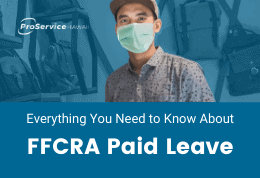
Update on FFCRA (as of 4/23/21):
While initial employer obligations to provide FFCRA paid sick and family leave ended on December 31, 2020, the new American Rescue Plan Act allows employers to voluntarily provide FFCRA paid leave benefits beginning April 1, 2021 through to September 30, 2021, and receive tax credits for such paid leave as well. For the latest information, read our latest FFCRA Guide (Updated 4/23/21).
About FFCRA:
On March 18, 2020, President Trump signed into law the Families First Coronavirus Response Act (“FFCRA”). The FFCRA goes into effect on Thursday, April 1, 2020. The Act provides for free COVID-19 testing and paid sick, family, and medical leave for employees impacted by COVID-19 at companies with less than 500 employees. The Act also provides for additional funding for unemployment benefits and Medicaid and food security programs.
Employee benefit:
Under this new law, employees of companies with less than 500 employees are entitled to:
- Sick Leave: 80 hours of sick leave, regardless of whether or not the employee has accrued sick leave.
- Child Care Leave: 12 weeks of job-protected leave, a combination of paid and unpaid leave.
To request leave on the basis of the FFCRA, an employee should complete and submit a request form with their supervisor/HR manager as soon as possible. Here is a sample FFCRA Employee Request Form we have created for our clients and employees.
Resources:
- Instructions on using the FFCRA Employee Request Form (PDF, updated 4/1/21)
- Blank FFCRA Employee Request Form (PDF for ProService Hawaii, updated 4/1/21)
Employer Question:
My employee’s child will be on a “hybrid” or rotating learning schedule (combination of in-school learning and at-home distance learning). Can my employee take FFCRA leave for the time period that his/her child is distance learning
Answer:
If the school is operating at a reduced capacity to comply with social distancing guidelines resulting in the employee’s child having no choice but to receive distance learning, FFCRA leave is available on the child’s remote-learning days provided the employee needs the leave to actually care for their child during that time and no other suitable person is available to do so.
Employer Question:
An employee is not comfortable sending their child to school even though the school plans to reopen in August. The school has given parents an option to keep their children at home and participate in optional distance learning. Can my employee take FFCRA leave for the time period that his/her child is distance learning?
Answer:
No. Because in-person learning is available, the school is not considered closed or partially closed.
Employer Question:
My employee has requested PTO to travel outside of Hawaii, which means she will be subject to the state’s mandatory 14-day quarantine order. Teleworking is not an option for my employee and my company is not exempt from providing FFCRA leave. Is this employee entitled to FFCRA leave even though she knows she will have to stay home for 14 days after her trip? Can I deny her PTO request?
Answer:
We understand that the U.S. Department of Labor (US DOL) is reviewing this scenario due to the number of states implementing 14-day travel quarantine periods across the country. However, until the U.S. DOL issues further guidance on this question, your employee is likely entitled to FFCRA leave. Of course, if you have a PTO or vacation policy already in place that prohibits employees from being absent from work for more than a specific number of days and the requested leave time exceeds that established policy, then you can deny the employee’s PTO request. Remember that under the FFCRA, paid sick leave because of COVID-19 is in addition to any existing sick leave policy provided by employers as of March 18, 2020. Employers cannot change their sick leave policy to circumvent FFCRA.
No. Emergency Paid Sick Leave for this reason is limited to the time the employee is unable to work because he or she is taking affirmative steps to obtain a diagnosis (e.g., for time spent making, waiting for, or attending an appointment for a test for COVID-19). Once an employee receives a negative test result, he or she is no longer entitled to Emergency Paid Sick Leave.
Reopening & Running A Business In Crisis
Find helpful tips for reopening and running a business during a pandemic on topics
like business strategy, people management, safety, remote work, and more.
Planning for Reopening
Resources
GET READY TO RESET
A big reset is happening right now. Business today now requires new business models and revenue streams, new staff relations, new relationships with our business partners, suppliers, landlords, and customers. When things “finally get back to normal,” our “new normal” will look very different from what we’ve known it to be.
Anticipating and preparing for this new business environment will take a little innovation, some patience, and a whole lot of grit. It will likely include many of the innovations businesses today are developing to survive right now. The important thing to remember is to know what you can control, make intelligent decisions, and rise into a refreshed economy, prepared.
HAVE A PLAN
If you want to reopen, stay open, and win long term in this new normal, you will need a comprehensive roadmap for the recovery marathon ahead. Whether it’s building off the State’s master plan and/or building your unique plan independently, start now and start somewhere. And be prepared to change your plan constantly as the environment changes.
Not sure where to start? We’ve got you covered. In the following FAQs, we’ll provide advice for defining your:
- Business priorities
- People strategy
- Planning for a safe opening
Resources
Think about what your business needs to not just survive, but thrive. Start by considering your business outlook for the short-term and long-term future. Think about your business priorities and needs for the first 30 days of reopening and for the next 90 days, 6 months and 12-months ahead.
As you plan ahead, we recommend thinking through three key buckets of your business operations:
1. PRODUCTS & SERVICES
Reflect on how your business, customers, partners, competition have adapted in the last several months.
What products and/or services will you stop, continue, and improve?
Find products and services you can dial up to discover efficiencies and opportunities to help differentiate your business. Pairing down or distorting categories is a great way to take stock of what you’re selling and how it fits today’s consumer needs. There may be opportunities to work with new vendors who can contribute to new inventory needs. Or think broader and explore new ways to create revenue by offering your products to other businesses who are seeking it.
Tips:
- Focus on top sellers
- Highlight your highest margin offerings
- Know what will sell immediately. And know what will sell consistently over 2+ months
- Try and test new products and services, even if it’s uncomfortable
- Choose the product/service mix that will differentiate you
Work with vendors to ensure supply for your priority products
Questions to think through:
- What mix of products should I sell?
- Do I need to offer something new?
- What are my top/fastest sellers?
- What has the highest margin?
- What vendors do I need to work with to ensure supply?
- How can I differentiate my offering?
2. CUSTOMER ACQUISITION
Consumer behavior will look a lot different as our economy recovers. Hawaii’s high unemployment rate will contribute to less discretionary spending. And people will shop more on a need versus want basis. For this reason and many others, businesses will need to get creative with their customer acquisition strategy and leverage all the tools available to them.
Tips:
- Re-engage all existing customers across all channels
- Spread the word, ask them to bring their friends, relatives, acquaintances, and neighbors.
- Keep investing in digital and virtual channels to complement your brick-and-mortar
- Identify partnerships to reach new customers
- Focus on what makes your brand unique and different
Questions to think through:
- How can I acquire NEW customers?
- How do I reengage existing ones?
- How can I leverage digital channels?
- How can I perfect my brand?
- How do I improve foot traffic?
- What partnerships can I develop to expand my customer base?
- How can I be a good partner?
3. REVENUES & EXPENSES
Preparing for short-term and long-term business success includes being ready for various scenarios and unknown variables. How will you respond if consumer demand declines even further or if the government mandates re-closure of your business? How will you adapt to changing government restrictions on tourism?
Tips:
- Predict business outlook if consumer demand is Poor, Moderate or Outstanding
- Forecast conservatively low revenue numbers for the first 3+ months
- Consider how state requirements will impact your bottom line
- Evaluate the following items monthly: revenue, minimum staff required to support operations, payroll required to fund employees, and minimum fixed/variable expenses needed to stay open
- Determine how many months will your cash flow last
Note: If you are concerned about financial longevity and were approved for a PPP loan, we strongly encourage you to spend your PPP funds strategically over the long-term instead of making maximum loan forgiveness your only priority. Refer to our Strategic Use of PPP Funds for more guidance on this topic.
Questions to think through:
- What are my 30, 60, and 90 day sales projections?
- What’s the minimum # of staff I need to operate?
- How much payroll is required to fund employees returning to work?
- What will my PPP dollars fund?
- What are my minimum levels of fixed and variable expense?
- How can reduce, defer and extend terms on larger expenses?
Resources
Now that you’ve gotten clarity on business priorities, it’s time to get tactical by focusing on your people strategy.
Start by identifying employee skill sets that are most essential for business moving forward. In addition to operational and technical skills, think about more general competencies that will be necessary for reinvigorating your service culture, such as problem-solving, adaptability, leadership and collaboration. Deciding your core team/who to bring back should be aligned with your business strategy. Know that your financial situation may drive key staffing decisions. For example: If you anticipate a 30% reduction of revenues, consider bringing back 30% less staff.
Note: Know that your new business environment may require skill sets now and in the future. Don’t be pressured on bringing everyone back. It’s ok to keep some employees on furlough. It’s also okay to leverage Hawaii’s high unemployment to hire new talent to fill any skills gaps in your team. Spend the money on the best people. Think of it as an investment in the future.
Tips:
- Identify your talent needs and who will be able to execute your priorities/core business functions
- Only bring back the minimum number of employees necessary to accomplish business priorities
- Consolidate roles to eliminate redundancies
- Cross-train your employees to give your business more flexibility
- Hire new talent if you identify competencies that your business needs but current employees don’t have
- Consider bringing back your employees in phases
Resources
Next, determine if employees should a) work 100% onsite, b) work 100% remotely from home, or c) work onsite and remotely. Review all employee’s responsibilities and identify any activities that require them to be physically on-site. If an employee’s job doesn’t involve primarily in-person/onsite work, we recommend you ask them to work from home to minimize their risk of exposure and enable you to reduce the total number of people on site. Partial remote work is also an option for those who need to be onsite periodically.
Onsite Work
- Customer service and vendor meetings
- Core functions
- Streamlined communication
- Culture and camaraderie
- Innovation
Remote Work
- Accessibility with technology
- Improved focus
- Reduced commute time
- “Safer at home”
- Childcare and/or eldercare
- Potential cost saving
- Obtain better talent
Questions to consider:
- Does this employee interact with customers face-to-face regularly?
- Can the employee’s work be done by phone, email, and/or online meeting?
- Which projects or tasks would not be completed if the employee was not physically on-site?
- Is there sufficient workflow for the employee to work remotely instead of onsite?
Resources
How do you get your employees excited to come back to work? Before you pick up the phone to call people back to work, spend some time planning how you will bring them back. Why? The way you bring your people back is your first step to rebuilding workplace culture and re-connecting your team.
Here are four tips to get you started.
1. RE-ENGAGE EMPLOYEES
Start off the conversation with a tone of enthusiasm and gratitude. Remember, some of your employees may not be looking forward to your call or may still feel frustrated at being furloughed. Tell your employee how much you appreciate them and how excited you are about the possibility of working with them again. Explain that the loosening of government regulations means your business may be reopening soon and you would like to discuss the situation with them.
Tips:
- Tell employees your business may be reopening soon on [date]
- Explain that you’d like to discuss their work situation with them
- Build enthusiasm by reminding them of the long term benefits of employment (i.e., health care benefits, self purpose, stability, restart their career, serving the community)
- Reconnect/remotivate your employees with their sense of purpose (remind them of your mission, vision, purpose and values etc.)
2. LISTEN & EMPATHIZE
Be prepared to really listen. Hear out and empathize with employee concerns and be prepared to address any employee concerns, such as workplace safety, scheduling changes and frustrations at the possibility of not earning as much as on UI. Note: If an employee refuses to return because they’re collecting richer UI benefits, explain that unemployment payments are generous right now, but UI benefits aren’t long-term. Additional benefits from the CARES Act ends in July.
Tips:
- Take time to “talk story” e.g. ask them how they’ve been doing (and share something about yourself)
- Discuss your commitment to keeping the workplace safe for employees and customers
- Really listen and don’t interrupt
- Playback and summarize their thoughts to check for understanding/demonstrate empathy
3. SET EXPECTATIONS
Your employees are aware that the workplace has changed but that doesn’t mean they can read your mind. Set clear expectations about what your business and their work will look like in the “new normal”. Tell them what you need from them, and how you intend to support them also.
Tips:
- Share your expectations for how they will work differently
- Specify what you need from them (how you expect them to show up)
- Share details on compensation, salary, and benefits (highlight and explain any changes)
- Discuss your business’ short-term and long-term goals for the road ahead (and how its different than before)
- Get specific about how you will support them and what you promise to do as their leader
4. ASK FOR FEEDBACK COMMITMENT
Find out if they are willing and able to return and will be fully committed. Make the ask: Are you in? Determine if the employee is willing and able to return, has any new work constraints, and if he/she is fully committed to going above and beyond. If an employee says they’re not available (or not interested in returning to work), you may not want to jeopardize their UI by giving them an offer to return. When an employee refuses an official offer to return to work, they may lose their unemployment benefits. If you really need them back, have that hard conversion to convince them and work out a solution. You can consider additional benefits to entice them e.g. stipend, per diem to cover food/meals to help make up for lost wages, etc.
Tips:
- Give employees the opportunity to voice their ideas about how to the business/work culture
- Find out scheduling details and employee availability
- Conclude by communicating next steps
Resources
Here are important HR topics or policies you should cover with your team:
- Scheduling plans for the next 30 days (and beyond, if possible). If your workforce will be a combination of remote and onsite employees, discuss any new processes and norms for interacting together as a mixed workforce.
- General changes in salaries, benefits, and compensation packages. Discuss changes to individual employee compensation during a one-on-one meeting to maintain privacy.
- PTO, vacation, and sick leave policies for the upcoming weeks and months. Clearly explain any policy changes to pre-COVID policy and articulate your rationale to diffuse employee concerns.
- New safe workplace policies and procedures. Discuss your commitment to keeping the workplace safe for employees and customers. Clearly articulate any new cleaning/disinfecting and symptom checking processes you intend to put in place, as well as the consequences for breaking protocol.
Resources
TEMPERATURE CHECKS:
Businesses may consider taking employee’s temperatures before they enter the building, but remember that not all COVID-19 patients experience a fever.
SELF-CERTIFY / PRE-SCREEN:
You can also require employees to read and commit that they have no symptoms related to COVID-19 before they enter your work-place each day. This will help to keep your work-site safe and ensure the health and wellness of your team and customers. Download the Employee Covid-19 Certification Notice (Updated 10/7/2020) which you can post at the entrance to your workplace.
NOTE ON PRIVACY:
While HIPPA rules generally prohibit asking employees about their health, the EEOC updated its guidance on the Americans with Disabilities Act and the coronavirus, explaining that employers have the right to screen employees for COVID-19. However, mandatory medical tests must be job-related and consistent with business necessity.
Resources
BE INCLUSIVE
If an employee has a higher risk for Covid-19, you are not permitted to exclude an employee from coming back to work or take any other unfavorable action simply because you are concerned about their health. According to the ADA, this is not allowed unless the employee’s disability presents a “direct threat” (significant risk of substantial harm) to his or her health and cannot be addressed by any other reasonable accommodation.
BE PROACTIVE
Proactively make accommodations that reduce or eliminate the direct threat of Covid-19, such as:
- Providing PPE beyond what all employees are expected to use, such as gloves and gowns
- Installing barriers to separate the at risk employee from colleagues or customers
- Changing job functions
- Alternating work schedules
- Modifying work locations
- Allow for remote work
ENSURE LEGAL COMPLIANCE
If an employee requests a reasonable accommodation because they have a medical condition that makes them higher-risk for Covid-19, here what you need to know:
- You may request a doctor’s note as documentation once your employee (or a third party, such as a doctor) informs you in writing or in conversation of the need for an accommodation.
- You can also ask clarifying questions about why the accommodation is needed and how the requested change will enable the employee to perform essential job duties.
- Generally speaking, you will be required to make the accommodation unless it creates an ‘undue hardship’ to your organization. Undue hardship is determined by assessing whether the requested accommodation will significantly impact other employees’ ability to perform their duties as well as the financial impact on the organization.
Life and work amidst COVID-19 presents several potential HR pitfalls, especially as you make decisions about how to staff onsite locations. Can you choose not to bring back older employees or employees with pre-existing health conditions if you want to keep them safe? Even if they did not request an accommodation? Can you pay to keep a COVID-recovered employee home because other employees are still worried about being infected?
Here are examples of discriminatory selection when it comes to deciding which employees to return to work:
- Bringing back only young employees perceived to be healthy individuals
- Choosing not to bring back other “high-risk” individuals
- Choosing not to bring back mothers with young children
Resources
All employers must create a safe working environment that gives employees the confidence to return to work, and customers confidence to engage. Properly disinfecting your entire business and designing customer-facing areas that work is critical. Here’s what we suggest you do:
1. PRE-CLEAN & ESTABLISH YOUR ONGOING CLEANING PLAN
- Review OSHA and CDC guidelines for detailed guidance and disinfecting how-to’s
- Order cleaning supplies and EPA-approved disinfectants and maintain at least a 30-day inventory
- Thoroughly clean and disinfect your business before you reopen
- Create an ongoing cleaning schedule for all areas (e.g. between customers, hourly, daily, or weekly)
- Identify and clean high-touch surfaces
- Avoid food contact when using disinfectants
- Add hand sanitizer stations, preferably touchless, at entrances/exits/checkout
- Follow OSHA/HIOSH guidelines for proper labeling, use and storage of chemicals
- Have an enhanced cleaning plan ready should a positive COVID-19 case be reported
2. CREATE PPE & PHYSICAL DISTANCING RULES
- Require employees and customers to wear a mask before entering
- Require employees to wear appropriate PPE
- Post signage to communicate key distancing rules and reminders in high-traffic areas
- Designate one location for any deliveries, require all vendors to wear face masks, disinfect all items, and only allow vendors to enter when escorted by an employee
3. DETERMINE PRODUCT HANDLING & LIMIT SHARING
- Determine standards for product handling so that it limits employee contact
- Consider “contactless” checkout options e.g. pick-up/curbside, self-checkout or contactless payment options (e.g. RFID credit/debit cards, Apple Pay etc.)
- Limit sharing equipment and consider assigning equipment/tools per person, per shift
- If sharing items is necessary, post clear directions about how to clean shared-use equipment
4. REORGANIZE YOUR FLOOR PLAN & TRAFFIC FLOW
- Ensure 6 ft spacing and add floor markers to help with distancing
- Designate specific entrances and exits to control traffic and reduce contact
- Install safeguards to prevent transmission of airborne particles that may carry the virus e.g. plexiglass or get creative with economical barriers like clear, thick plastic
- Establish paths (e.g. one-way, clock-wise) to minimize proximity for customers and employees
5. LIMIT THE NUMBER OF PEOPLE IN A CLOSED SPACE
- Reduce worksite occupancy based on county and state capacity rules. Establish an occupancy monitoring protocol to maintain the appropriate capacity
- Adapt breakrooms/waiting areas for social distancing and stagger breaks to prevent crowding
Flexible Operations
Here’s what our banking partners at American Savings Bank say:
- Identify your immediate cash needs and demands
- Calculate the cash you need to cover your business’s core operations for at least the next 45 days
- Run and update each week a cash flow forecast to monitor your short-term cash position carefully.
If you do not have sufficient cash in the bank to cover these 45-day expenses, consider the following actions:
- Collect on accounts receivables—now is not the time to let others hold onto the cash that is rightfully yours
- Draw on your existing line of credit (if you already have one) to establish at least a 45-days worth of cash reserves. Consult your banker to determine if it makes sense to hold an even larger buffer.
- Apply for a Small Business Administration Loan—there are several available options to employers during this pandemic.
Note: ProService Hawaii has outlined several business relief programs that are currently available to employers in our Relief Programs Guide.
Resources
- The Small Business Guide to Relief Programs for COVID-19 (ProService Hawaii)
- SBA Disaster Assistance in Response to the Coronavirus (Small Business Administration)
Thousands of employees in Hawaii still receive live checks. For those who aren’t set-up with direct deposit, the stakes of going to the bank or a check-cashing facility to deposit their physical checks as coronavirus (COVID-19) continues to threaten public health are high.
If some employees still receive live checks, we strongly urge employers to advise your team to switch to direct deposit. Should the coronavirus reach crisis levels, postal systems or banks may choose to adjust their operations. Switching to direct deposit ensures that employees receive a paycheck without hiccups. Similarly, setting-up and becoming familiar with mobile banking is strongly encouraged.
In recent days employers have been faced with very difficult and unanticipated situations in the workplace. As the coronavirus continues to spread across the state and country, employee absences from the workplace will be more frequent—whether related to personal or family illness due to the virus, school closures, voluntary or involuntary quarantines, fear of contracting the virus, etc.
As an employer, you need to be ready to adapt your business practices to maintain critical operations.Here are some things you might consider:
- Cross-training employees to carry out essential functions so you can operate when essential staff are out.
- Identifying alternative suppliers to meet supply chain needs.
- Prioritizing customers with the greatest needs.
- Preparing to temporarily suspend operations if necessary.
Remote Work Tips
At this time, the goal should be to prevent, or decrease, the spread of COVID-19 in the workplace and lower the impact of COVID-19 onto your business operations. Now is the time for proactive, creative thinking to safeguard your employees’ health and your business. Here’s practical steps you can take to be prepared for any emergency.
Assess employees’ core work & in-person requirements:
Determine what people and resources are required for your business to operate. Take a look at existing employee roles and responsibilities. Identify the following:
- What has to get done on-site and in-person
- What can be done, even partially, through remote work.
For work that requires physical presence (e.g. restaurant work), start thinking through your contingency plan. This may include engaging a temp agency to quickly find healthy contractors to do the work. Or, this could include implementing on-call staffing policies to manage short staffing.
For work that can be handled outside the workplace, consider reevaluating your remote-work policies. Encourage managers to challenge default assumptions about the flexibility of certain roles as they think through their options.
Evaluate resources & leverage technology:
Maybe you’ve determined that an employee doesn’t need to be physically in the office to do their core work. But do they have the right resources and access to do their job at home?
One of the great ways to stay connected if you pursue remote work is to use technology. Things like setting up employees with video conferencing, leveraging document sharing tools like Google Docs, or loaning out laptops or other devices to employees that don’t have access to a personal device to do work.
Determine what tools the employee needs to do their job. For example:
- Desktop or laptop computer
- Internet access
- Secure access to applications and data
- Online communication and collaboration tools like Zoom or GSuite
- Home phone or cell phone with adequate data
Test your plan & get input:
Your plan is more likely to be successful if you get buy-in from employees and partners. Invite your employees to help develop and review the plan. If it’s not possible to talk with every team member, try sampling a variety of departments in your organization.
Consider testing out your plan to help detect gaps or problems that need attention, and sharing your completed plan with employees. Explain what benefits are available to them, including paid time off, flexible scheduling,and health care coverage.
Establish a communications protocol
Last but not least, communicate with your employees. Set-up a protocol on how to reach everyone (G-chat, text, phone call etc.) to handle staffing and work loads. If you’ve updated your remote-work plans, share it widely with all your employees and be available to answer questions as they arise. Consider organizing a company huddle to address concerns and align everyone on the plan moving forward.
Resources:
- Free ebook: Unexpectedly Transitioning to Remote Work (ProService Hawaii)
- Remote Work Team Norms Checklist (ProService Hawaii)
- How Google is helping businesses and schools stay connected during COVID-19 (Google Cloud)
- Support during the COVID-19 pandemic (Zoom Video Conferencing)
- Webinar: Remote work 101 (ProService Hawaii)
If an all-remote or majority-remote workforce is not practical for your business, ideas to discuss among your management and operations teams are:
- Splitting or staggering shifts to lessen the amount of people in the workplace at one time
- Cross-training employees to perform critical functions so that your business is able to operate even if key employees are absent.
- Identifying truly critical functions your business needs to run.
Temporarily weeding out the not-so-critical functions so you are able to staff your office and/or remote workforce appropriately without increasing the risk of the spread of COVID-19.
You’ve decided that remote-work makes sense for your business and your team. Now what?
Some of your team may feel thrilled about the possibility of working remotely—but not everyone will feel that way. Some may dread it. But if remote work is our new reality, your role is to help employees make the best of it.
Here are some quick tips:
Tip #1: Set up your workspace
- Pick one spot and dedicate it to work
- Keep everything in one place
- Stay off the couch
- Get dressed
Tip #2: Establish hours, breaks & boundaries
- Create a routine — and stick with it.
- Set a regular time for lunch and breaks
- Prioritize tasks and chunk your time
- When the work day is over, it’s over
Tip #3: Anticipate and plan to deal with distraction
- Communicate your needs
- Coordinate schedules
- Create and reinforce boundaries
- Use headphones
Tip #4: Take care of yourself physically and mentally
- Move your body
- Connect with people
- Choose your mindset
For more detailed tips, download a free copy of our ebook: For the full detailed version of our tips, download a free copy of our ebook: Unexpectedly Transitioning to Remote Work.
Resources:
- Free ebook: Unexpectedly Transitioning to Remote Work (ProService Hawaii)
While remote work is nothing new, it’s the first time so many people have made the shift at once — so it’s natural for some to find the transition challenging.
One of the biggest questions many employers have is how they will be able to communicate with and manage their team. How will you know if people are getting their work done? How can you build relationships if you’re not seeing your people every day? The uncertainty of how things will work can add to an already stressful situation.
Fortunately, there are things you can do to make communication and management easier.
Tip #1: Stay connected while remote
- Pay attention to the quality of your communication
- Think about when and how often you reach out
- Strengthen customer relationships
Tip #2: Give clear direction, then let people do their jobs
- Articulate your expectations
- Establish clear deliverables
- Then back off
Tip #3: Run effective meetings
- Practice using new platforms
- Set the ground rules
- Have an agenda
- Stick to video
Tip #4: Make people feel supported
- Use emotional intelligence
- Make sure your staff doesn’t get burned out
- Ask for feedback
For the full detailed version of our tips, download a free copy of our ebook: Unexpectedly Transitioning to Remote Work.
Reopening Videos
Update from the Experts
HR Practices & Policies
Our experts provide practical things employers can act on today. From working from home to stress management tips, get ideas and inspiration to consider for your workplace.
- Tiffany Donnelly, Director of HR at ProService Hawaii
- Janina Abiles, Director of HR & Safety Training
Update From the Experts
COVID-19 Workplace Scenarios
Our experts provide quick answers to the top questions we're hearing from our clients (and their employees) right now.
- Michelle Kim Stone, Corporate Counsel & Director of Legal Operations at ProService Hawaii
- Janina Abiles, Director of HR & Safety Training
What's Working? What's Not?
What's Next For Your Favorite Restaurant
This webinar was recorded on July 9, 2020.
We sat down with an amazing group of restaurant leaders to talk about their experiences through reopening, lessons learned, and their thoughts on what's ahead in the next few months.
Video Timestamps
[4:17] What's working – takeout, menus, and specials
[10:30] What's next – plans for coming months
[28:40] Getting the word out and marketing strategies
[37:52] Putting safety first
[45:40] Learning from corporate or mainland counterparts
[55:58] Closing Thoughts
Reopening and Operating Your Educational Program
This webinar was recorded on July 1, 2020.
Learn suggestions and best practices for protecting your staff and students, complying with social distancing guidelines, and implementing protective measures to prevent the spread of coronavirus in an education environment.
Working in The New Normal: A Training for
Healthcare Employees
This webinar was recorded on June 16, 2020.
Learn suggestions and best practices for protecting your employees, complying with social distancing guidelines, and implementing protective measures to prevent the spread of coronavirus in a healthcare setting. Examples of companies that benefit from this course: medical and dental practices, chiropractic offices, vision care offices, diet and health coaching services, urgent care, and walk-in clinics.
The New Normal: Operating Your Construction Company
This webinar was recorded on June 5, 2020.
Learn suggestions and best practices for protecting your employees, complying with social distancing guidelines, and implementing protective measures to prevent the spread of coronavirus in a construction worksite.
The New Normal: Operating Your Professional Office
This webinar was recorded on June 5, 2020.
Learn suggestions and best practices for protecting your employees, complying with social distancing guidelines, and implementing protective measures to prevent the spread of coronavirus in an office work environment.
Working in the New Normal: A Training for Employees
This webinar was recorded on May 29, 2020.
Share this video with your employees to educate them on practical strategies and steps to work safely in the “new normal”. In this webinar we’ll cover 3 important aspects:
- Ensuring you are healthy to work
- Keeping a clean and safe work environment
- Delivering safe customer service
Reopening and Operating Your Restaurant
This webinar was recorded on May 29, 2020.
Learn to protect your employers, customers, and ensure a safe worksite for everyone. Ensure you are familiar with the Department of Health Dine-in Guidelines.
Reopening and Operating Your Retail Business
This webinar was recorded on May 26, 2020.
In this course, we discuss how to protect your employees, your customers, and your store with appropriate cleaning, physical distancing, and training.
Recipes for Reopening
This webinar was recorded on May 21, 2020.
Hear our restaurant panelists discuss the challenges they face and how they're overcoming them to reopen their dine-in services. Our panelists include:
- Jason Wong, Sysco Hawaii
- Don Murphy, Murphy's Bar & Grill
- Erik DeRyke, ProService Hawaii
The New Normal: How to Make a Comeback
This webinar was recorded on May 20, 2020.
Hear how thought leaders in our community are pivoting their businesses, and using COVId-19 driven innovations to define their New Normal. Our panelists include:
- Elisia Flores, L&L Hawaiian Barbeque
- Matt Heim, HONBLUE
- Christine Lanning, Integrated Security Technologies
- Ben Godsey, ProService Hawaii
- Moderator: Steve Petranik, Hawaii Business Magazine
Reopening Your Business to Survive and Thrive
This webinar was recorded on May 12
Get guidance from our panel for reopening your business to not only survive but to thrive. Our panel of experts include:
- Scott Maroney, Crazy Shirts
- Nelson Befitel, ProService Hawaii
- Jordan Conley, Obsidian HR & ProService Hawaii
- Elena Martinez, ProService Hawaii
Resources From This Webinar
Running a Business in Crisis Videos
Creating a Pandemic Response Plan
This on-demand training was recorded on August 18, 2020.
Ensure safety for you and your employees with our expert guidance on how to create a workplace pandemic response plan. Learn essential strategies for assessing exposure risk, implementing workplace controls and handling a positive case.
Remote Work
This webinar was recorded on March 26, 2020
We provide tips and strategies to stay productive and connected with your team. Hosted by: Marissa Page, Learning & Development Specialist, ProService Hawaii.
Timestamps
[5:23] Intro: Work as we know it is changing
[8:20] Webinar goals
[10:06] Tips to boost productivity
[13:00] Set-up your workspace
[31:31] Hours, breaks and boundaries
[39:22] Anticipate distractions
[45:27] Physical and mental health
[48:27] Choose your mindset
Ergonomics
This webinar was recorded on April 9
We discuss causes and risk factors in your daily work and how to utilize proper postures and stretching exercises. Hosted by Jason Propst, Safety Training & Development Specialist.
Timestamps:
[1:38] Ergonomics defined
[2:56] Cause and risk factors
[9:56] Types of injuries
[12:37] Ergonomic solutions
[20:46] Ergonomic exercises and stretches
Leadership Series #3: Five Fundamental Components of Resilient Leadership
We discuss the components needed to drive resilience as a leader.
Timestamps:
[1:09] Heart & head
[2:30] Mission driven
[4:18] Speed over elegance
[5:21] Own the narrative
[6:32] Embrace the long view
Leadership Series #4: Adopting A Growth Mindset
We discuss how to develop a growth mindset that can help you reinvent your business and seek opportunities for future growth.
Timestamps:
[0:47] Fixed mindset vs. growth mindset
[2:17] Leadership mindsets
[4:46] Expectations
[5:46] Reinvention
[6:20] People strategies
Relief Programs
Learn about programs available to help you
retain employees and sustain your business during this crisis
There are several government relief programs now available to small businesses and their employees. You may have heard of a few:
Small Business Loans:
- Paycheck Protection Program (PPP)
- Economic Injury Disaster Loans (EIDL)
- SBA Bridge Loan
- SBA Debt Relief
Employer Tax Credits:
- Employee Retention Tax Credit
- Payroll Tax Deferral
Employee Leave:
- Family First Coronavirus Response Act
Trying to identify which one is most applicable and beneficial for your situation can be complicated, but it doesn’t have to be.
Keep on reading to learn more about these programs in-depth. Or, read our SMB Guide to Relief Programs for COVID-19 to get an overview of each one.
Resources:
Updated on 4/24: The CARES 2 Act, a $484 billion relief bill, has been signed into law. Of this, the Paycheck Protection Program (PPP) will receive an additional $310 billion and the Economic Impact Disaster loan (EIDL) program will receive $60 billion.
The Coronavirus Aid, Relief, and Economic Security Act, or CARES, is a $2.2T relief program that was passed by Congress on March 27, 2020.
The historic stimulus package offers relief to employers and employees in the form of 1) enhanced SBA loans, 2) employer tax credits, and 3) expanded unemployment insurance benefits.
One of the CARES Act’s primary benefits to small business owners is the Paycheck Protection Program (PPP) SBA loan. This program will provide businesses with cash-flow assistance through 100% federally guaranteed loans in order to retain your employees and maintain your payroll during this emergency.
Resources:
- The Small Business Owner’s Guide to the CARES Act (US Senate Committee)
Resources
If your PPP loan was approved, congratulations! With proper planning, PPP funds can help you survive the eight weeks after loan disbursement and rebuild, re-staff and thrive long after that.
While maximizing PPP loan forgiveness is very important, we believe the best course of action is to shift the focus away from maximizing loan forgiveness, and instead solve for these two business goals for your business:
- How to survive the next eight weeks
- How to gain fast traction post-COVID to thrive long-term
If you are a ProService client, please contact us to schedule a consultation to help you develop your strategic business plan.
Resources:
Resources
Updated June 17, 2020:
The SBA released two loan forgiveness application forms aligned with the new rules of the PPP Flexibility Act:
- Full Forgiveness Application Form
- EZ Forgiveness Application (which requires fewer calculations and less documentation)
If you meet the criteria listed below, you are eligible to use the EZ Forgiveness Application. Otherwise, you should use the Full Forgiveness Application form.
- Are self-employed and have no employees; OR
- Did not reduce the salaries or wages of their employees by more than 25%, and did not reduce the number or hours of their employees; OR
- Experienced reductions in business activity as a result of health directives related to COVID-19, and did not reduce the salaries or wages of their employees by more than 25%.
While you can’t submit your loan forgiveness application until your 8-week period ends, there are things you can do to get prepared today.
Updated June 11, 2020:
On June 5, 2020, the Paycheck Protection Program Flexibility Act (PPPFA) was signed into law and significantly changed the original loan forgiveness rules of the Paycheck Protection Program (PPP).
Here are the changes as a result of PPPFA:
- Covered Period was extended from 8 weeks to an optional 24 weeks
- Reduced payroll expenditure requirement from 75% to 60%
- Increases amount you can use for covered non-payroll items (rent/utilities) to 40%
- Deadline to restore payroll levels extended from June 30, 2020 to December 31, 2020
- Loan maturity extended from 2 years to 5 years (for loans made after 6/5/20)
- Loan payment deferral changed from 6 months to the date on which the SBA remits the loan forgiveness amount to the lender. If the borrower does not apply for forgiveness, payments will be deferred for 10 months.
- Borrowers will not suffer a reduction in loan forgiveness if they are able to document that they are unable to re-hire employees from 2/15/20 and hire similarly qualified employees, or that they are unable to return to the same level of business activity as of 2/15/20 due to compliance with COVID-19 safety or government requirements.
The deadline to apply for the Paycheck Protection Program (PPP) has been extended to August 8, 2020.
To apply, download the PPP Application (last updated 6/24/20) and apply through any existing SBA lender or FDIC institution. For more information on PPP, visit the SBA website.
If you are a ProService Hawaii client and need assistance with your PPP application, please contact us directly.
Updated July 29, 2020
The Continuing Small Business Recovery and Paycheck Protection Program Act is new legislation currently undergoing review in Congress. If passed as currently written, this act would provide additional assistance to small businesses that are struggling to recover from the impacts of the ongoing COVID-19 pandemic.
There are a number of components to this bill, however the most pertinent for our partners are:
- Enhanced changes to PPP loan forgiveness provisions which would make it easier for employers with loans less than $2M file for forgiveness because of less documentation requirements and more flexibility in what is allowed as a non-payroll expense.
- Potential for a second PPP loan for businesses that need additional funding, with more focus on businesses with smaller revenue and staff sizes.
Please read this important update to get the latest information. As we receive more information, we will continue to provide updates.
There are two tax programs you might want to learn more about: 1) Employee retention tax credit, and 2) Payroll tax deferral.
Employee Retention Tax Credit
The Employee Retention Tax Credit is designed to encourage businesses to keep employees on payroll by providing a refundable tax credit of 50% of up to $10,000 in wages.
You are eligible if your business is fully/partially suspended because of a government order, or if you have 50% reduction in quarterly receipts because of COVID-19.
Here are the key points:
- The tax credit is equal to 50 percent of qualified employee wages (including allocable qualified health plan expenses)
- If you have <100 full-time employees, you can claim credit for wages paid to all employees, up to $10,000
- If you have >100 full-time employees, you can claim credit for employees furloughed or hours reduced b/c of employer's closure or economic hardship
- Tax credit is provided through 12/31/20
- Not available if you have a PPP loan
Payroll Tax Deferral
As an employer, you are required to deposit your share of payroll taxes to the U.S. Treasury electronically either semi-weekly or monthly. With the Payroll Tax Deferral program from the CARES Act, you may defer paying your share of payroll taxes owed on wages paid through 2020.
Here are the key points:
- Businesses and non-profit employers are eligible to defer their payroll taxes. If you receive a loan under the SBA Paycheck Protection Program (PPP), you cannot take advantage of this program.
- Payroll taxes that are deferrable include employer portion of FICA, employer and employee representative portion of Railroad Retirement taxes and half of SECA tax liability
- Deferred taxes are due in two installments: 50% by 12/31/21, and 50% by 12/31/22
For more information, read our guide: The Small Business Guide to Relief Programs for COVID-19
Resources
Updated June 15, 2020:
The Small Business Administration (SBA) has announced that they will begin accepting new Economic Injury Disaster Loan (EIDL) and EIDL Advance applications again from all eligible small businesses and U.S. agricultural businesses impacted by COVID-19 starting June 15.
What is an EIDL?
EIDLs are low-interest SBA loans (3.75% for businesses, 2.75% for not-for-profits) which can be used for debts, payroll, accounts payable and other bills that can’t be paid because of the disaster’s impact, and that are not already covered by a Paycheck Protection Program (PPP) loan,
The EIDL Advance program allows eligible applicants to receive up to a $10,000 advance, which do not need to be repaid, even if they are denied loan approval.
If I already have a pending EIDL application, should I reapply?
If your previous application did not include a request for the Advance (or you applied before the Advance was made available), you should reapply. Otherwise, the SBA is processing all applications on a first-come, first served basis so you do not need to send in a new application.
Is EIDL different from the Paycheck Protection Program (PPP)?
Yes, the PPP and EIDL are separate loan relief programs that are available to small businesses impacted by COVID-19. An eligible business can use funds from both programs to help with certain business expenses during this crisis. For more information on PPP and EIDL program rules, watch this quick video.
Read our next FAQ for information on how to apply. Visit the SBA’s EIDL website to learn more about the program and eligibility. To apply online, click here.
Updated on 6/16/20:
For those with a pending EIDL application:
If your previous application did not include a request for the Advance (or you applied before the Advance was made available), you should send in a new application.
Otherwise, if you previously applied for an EIDL and/or the Advance, you do not need to reapply. The SBA is processing all applications on a first-come, first served basis.
For those who already received EIDL or an advance due to COVID-19:
Businesses are limited to one EIDL per disaster. If you already received an EIDL and/or advance due to COVID-19, you are no longer eligible
How to Apply:
Step 1 – Visit the SBA’s online application website. Please note that due to the large number of requests, you may experience delays on the site.
There are 3 SBA forms that will be required (SBA Form 5, SBA Form 413, and SBA Form 2202) in addition to other information listed below. These forms are provided electronically/online as part of the SBA online application.
- Loan application (SBA Form 5), completed and signed (this is electronic/online in the portal)
- Tax Information Authorization (IRS Form 4506-T), completed and signed by each applicant, each principal owning 20 percent or more of the applicant business, each general partner or managing member; and, for any owner who has more than 50 percent ownership in an affiliate business. Affiliates include, but are not limited to, business parents, subsidiaries, and/or other businesses with common ownership or management
- Complete copies, including all schedules, of the most recently filed Federal income tax returns for the applicant business; an explanation if not available
- Personal Financial Statement (SBA Form 413) completed, signed, and dated by the applicant, each principal owning 20 percent or more of the applicant business, and each general partner or managing member
- Schedule of Liabilities listing all fixed debts (SBA Form 2202 may be used)
Step 2 – Once you have submitted your documents, the SBA will review your materials and estimate your total loss. A loan officer will determine your eligibility and possibly request additional information or documentation. The goal is to arrive at a decision within 2-3 weeks of your application submission.
Step 3 – Loan Closing and funds disbursed – Your loan closing documents will be provided for your signature. Once signed documents are received the initial disbursement of a maximum of $25,000 will be disbursed. Subsequent disbursements will be scheduled until you receive the full loan amount.
If you need more information, you can:
- Review SBA’s Disaster Loan Three-Step Process PDF
- Visit SBA Disaster Loan Assistance website, note to expect delays due to the volume of requests
- Call the SBA’s customer service center at 1-800-659-2955 (TTY: 1-800-877-8339), note to expect long hold times due to the large volume of requests
- E-mail [email protected]
If you are ready to apply for an SBA disaster loan, click here to submit your application online.
The Small Business Relief & Recovery Fund is a reimbursement grant available for businesses with a commercial location on Oahu. This includes not for profits on Oahu.
The grant is up to $10,000 on a first come first served basis and application launches on Monday, May 18th.
Our recommendations are as follows:
- Determine if your business is eligible (see below)
- If you are eligible, we advise you to prepare your documents in advance because speed to complete your application will be critical. (see step 2 below)
- Determine your assigned Federal Credit Union based on the last 4-digits of your GET number (see chart below)
- Get your online application link by visiting oneoahu.org/small-business on Monday, May 18th at 12-noon.
As with previous relief programs, we expect the demand will be high and funds will be depleted quickly.
Step 1: Determine your eligibility
There are 8 requirements for this grant, here are the first 3:
- Eligible business types:
- Businesses registered with the Hawaii Department of Commerce and Consumer Affairs and sole proprietors.
- Non-profit organizations registered with the Hawaii Department of Commerce and Consumer Affairs and designated as tax-exempt under section 501(c)(3) or 501(c)(19)
- Businesses with less than $1,000,000 in annual gross revenue
- Have 30 or fewer employees (full-time or part-time)
Click here for the full list of Qualifications & Requirements.
Step 2: Prepare Required Documents
We highly recommend you prepare your documents as soon as you can so you are early to submit your application when the program opens.
It is critical that you submit ALL of your required documents. An incomplete application will not be processed.
Here is the list of documentation required: Small Business Relief & Recovery Application Information
Step 3: Determine your assigned Federal Credit Union
Refer to the list below as an example of how your credit union will be assigned – based on the last four digits of your GET number (not considering any dashes).
For example, if the GET number is 1234567-01, then the last four would be 6701 and fall to credit union #3. Links to the credit unions will be available when the program opens Monday, May 18th at 12:00pm.
- Credit Union #1 0000 – 2500
- Credit Union #2 2501 – 5000
- Credit Union #3 5001 – 7500
- Credit Union #4 7501 – 9999
Step 4: Get your online application link
On Monday, May 18th at 12-noon go to: (oneoahu.org/small-business) (refresh the page) and look for the application link for your assigned Credit Union. Please call that credit union for any questions specific to your application
Application Notes:
- Applications will begin Monday 5/18 – we advise you prepare your documents in advance
- You DO NOT need to be a member of the credit union to apply
- You can go directly to the funds page at: oneoahu.org/small-business.
- As the applications come in, they will be placed in a queue and if they meet all the requirements, they will go to the top of the list (1st in, 1st pay)
What If I have more questions?
Please see this list of Frequently Asked Questions
The grant may be used to pay:
Costs incurred from business interruption due to the COVID-19 Emergency Proclamations promulgated on March 20, 2020
Examples of expenditures include Rent, Payroll, Utilities, and costs incurred to meet requirements of social distancing and employee/customer safety such as provision of hand sanitizers, disinfecting, installation of barriers/protection devices, signs and electronic/automation equipment
The grant may not be used for:
Those costs in the listing for reimbursable expenses that have already been compensated for under Federally-funded CARES Act funds such as Paycheck Protection Plan (PPP) or Economic Injury Disaster Loan (EIDL). Applicants must certify these funds, if received, did not pay for items being claimed.
How will funds be dispersed?
This relief will be in the form of a grant through federal credit unions (you do not need to be a current credit union client to apply):
- Hawaii Pacific FCU
- Hawaii State FCU
- Hawaii USA FCU
- Honolulu FCU
There are several relief programs available to small business employers impacted by COVID-19. Trying to identify which one is most applicable and beneficial for your situation can be complicated.
But it doesn’t have to be. We’ve summed it up for you in this guide: The Small Business Guide to Relief Programs for COVID-19. Get started by selecting which scenario is closest to your situation and review the programs available to you and your employees.
On Saturday, August 8th, President Trump signed four executive orders related to COVID-19 relief. While two of the orders are pertinent to businesses, it has been reported in the media that all of the orders may be subject to constitutional challenge, thereby impacting implementation. Consequently, more time is needed to determine when and how the relief actions proposed by President Trump will take effect.
In the meantime, please read the following summary of the relevant orders:
- Federal Unemployment Benefits (Updated 8/27): Governor Ige announced that the State of Hawaii will be applying for federal aid for the additional $300/week in unemployment benefits. This new benefit would replace the expired $600/week benefit under the CARES Act. At this time, the State Unemployment Insurance Department is awaiting guidance from the federal government before it can initiate additional unemployment benefits.
- Federal Payroll Tax Deferral: The “Memorandum on Deferring Payroll Tax Obligations in Light of the Ongoing COVID-19 Disaster” calls on the U.S. Treasury Department to allow employers to defer payment of an employee’s share of the Social Security portion of the payroll tax, or 6.2%, from September 1 to December 31, 2020 for all employees earning less than $104,000 a year. Note that this is a deferral, not a tax cut, meaning the payroll taxes will still be due at the end of the deferment period.
Again, none of the proposals summarized above have been implemented. Rest assured that as we receive more information we will continue to provide updates that affect our partners.
Paycheck Protection Program Round 2 (PPP2)
The Paycheck Protection Program (PPP) originated as a component of the CARES Act in March 2020. It is an SBA forgivable loan program designed to help small business employers cover payroll and other qualified business expenses.
In December 2020, a new COVID-19 relief package was signed into law that provided an additional $286 billion for a second round of PPP loans (PPP2).
When to apply for PPP2: Participating lenders are accepting PPP loan applications between January 11 and March 31. Note these important dates:
- January 11-12: Early access for first-time PPP loans at community financial institutions (CFI)
- January 13-14: Early access for second-time PPP loans at CFIs
- “Shortly thereafter” – All other lenders will begin accepting PPP2 applications from eligible businesses “shortly thereafter” or January 15 at the earliest
- March 31 – Last day to apply for a PPP2 loan
Funds Use and Covered Period:
If you are approved for a PPP2 loan, you have 8-24 weeks to spend the funds on eligible payroll and non-payroll expenses such as:
Payroll Expenses:
- Salaries/Wages
- Health Insurance
- SUTA Tax
- Group Disability Insurance (TDI)
Non-Payroll Expenses:
- Mortgage interest, rent/lease
- Utilities
- Personal Protective Equipment PPE, cleaning products/services, supplier costs
More Resources:
To be eligible for a PPP2 loan, you must:
- Have less than 300 employees
- Show a 25% decrease in gross receipts for any calendar quarter of 2020 when compared to the same quarter in 2019
- [If you already received a PPP loan] Have used or will use the full amount of your PPP1 loan
- Have not permanently closed
Visit the SBA website to apply for PPP2:
Read our PPP2 Cheat Sheet to learn what’s changed in PPP2. Read our PPP2 Cheat Sheet to learn what’s changed in PPP2.
Yes! PPP2 is open to all eligible first and second time borrowers. However, applicants for a second loan must certify that “current economic uncertainty makes this loan request necessary to support the ongoing operations of the applicant.”Yes! PPP2 is open to all eligible first and second time borrowers. However, applicants for a second loan must certify that “current economic uncertainty makes this loan request necessary to support the ongoing operations of the applicant.”Yes! PPP2 is open to all eligible first and second time borrowers. However, applicants for a second loan must certify that “current economic uncertainty makes this loan request necessary to support the ongoing operations of the applicant.”
The SBA defines gross receipts as: all revenue in whatever form received or accrued (in accordance with the entity’s accounting method) from whatever source, including from the sales of products or services, interest, dividends, rents, royalties, fees, or commissions, reduced by returns and allowances.
It’s important to review your gross receipts because one of the eligibility requirements is to show a 25% decrease for any calendar quarter of 2020 when compared to the same quarter in 2019.
It can be compared in two ways: Comparing annual gross receipts between any quarter in 2019 with the same quarter in 2020. Or, by comparing annual gross receipts between 2019 and 2020 as reported on a completed tax return.
It’s defined as an institution with assets less than $1B. Institutions that meet this criteria in Hawaii include: Hawaii National Bank, Ohana Pacific Bank and Finance Factors.
No. If eligible, you’ll have to choose which program—PPP2 or SVO—to apply for. Businesses who receive a PPP loan after December 27, 2020 are not eligible for the SVO grant. Here’s a list of businesses eligible for the SVO grant:
- Live venue operators or promoters
- Theatrical producers
- Live performing arts organization operators
- Relevant museum operators, zoos and aquariums who meet specific criteria
- Motion picture theater operators
- Talent representatives
- Each business entity owned by an eligible entity that also meets the eligibility requirements
Click here to learn more about the SVO grant and program rules on the SBA’s website.
If you’re considering applying for a PPP2 loan, we recommend these next steps:
#1: Understand the basics of PPP2.
- Watching our recent webinar “Unlocking PPP2 and the new COVID-19 Relief Stimulus”
- Read our Cheat Sheet on PPP2
#2: Review your gross receipts for 2020 and compare them to 2019. If you’re a second-time borrower, you’ll need to show proof of a 25% reduction in gross receipts from one calendar quarter in 2020 compared to the same calendar quarter in 2019.
#3: If you’re a ProService Client, contact us to let us know you intend to apply for a PPP loan.
Not yet a ProService partner?
Learn how ProService can help your business through the current crisis. Click here to request a free consultation today.
Local Loan & Grant Resources
Description:
Eligible companies may receive up to $10,000 for expenses related to pivoting or adjusting the company, its operations, products, services, or related items to meet the new economic environment. The expenses must be directly related to, and necessary for, the purposes of the Hawaii Business Pivot Grant program. Ordinary expenses of the company and expenses that will be completed AFTER December 31, 2020, will not be allowed.
Eligibility:
- Companies or non-profits (501(c)(3) or 501(c)(19)) registered to do business in Hawaii that have fewer than 100 employees at the time of submission of application.
- The company must have suffered an economic injury due to the COVID-19 pandemic.
- An eligible business must actually operate in a physical commercial space in Hawaii. Home-based businesses are ineligible. Agricultural businesses are eligible if they meet all qualifications. Eligibility will be determined by assessing Tax Map Key associated with the location of business operation.
- Must have been in business prior to March 20, 2020.
Application Deadline: Applications will be available starting October 22, 2020 until November 31, 2020
For more information:
- Call: 808-657-3495
- Email: [email protected]
HCRC Emergency Loan Program (HELP)
Description: The Hawaii Community Reinvestment Corporation (HCRC) is providing short-term bridge loans and term loans to non-profit organizations and mission-aligned small businesses that are otherwise unable to secure financing and are in immediate need of capital as a result of the COVID-19 crisis and mandatory business shut down.
Eligibility:
- Businesses (non-profit and mission-based for-profit businesses) registered to do business, headquartered and physically located in the State of Hawaii
- In good standing, in operations for at least one year
- Have annual revenue of at least $100,000
- Were financially stable prior to the COVID-19 crisis.
Application Deadline: Accepting applications until funds are no longer available.
For more information:
- Call: 808-532-3110
- Email: [email protected]
State of Hawaii COVID-19 PPE Distribution Program
Next Key Date: All orders must be submitted by Nov. 15, 2020 and will be shipped directly to you.
Description: The State of Hawaii COVID-19 PPE Distribution Program is an initiative created by SB126 Act 9 of the 2020 Legislative Session to purchase and distribute at no cost critical Personal Protective Equipment (PPE) to Qualified Recipients to assist them in maintaining their critical facilities and businesses during the COVID-19 emergency. Distribution is tentatively anticipated to occur from mid October – December 2020, supplies permitting.
Eligibility:
- Independent Medical Providers – Small Hospitals, Community Health Centers, Clinics, Doctors, Dentists, Labs, Pharmacies, Therapists, Blood and Plasma Banks and Dialysis Centers
- Child Care Providers – Department of Human Services licensed or registered Child Care Providers (e.g. – Family Child Care Homes, Group Child Care Centers, Group Child Care Homes, Infant & Toddler Child Care Centers, and Before and After School Care Programs)
- Eldercare Facilities – Department of Health licensed or registered facilities that provide care for the elderly (e.g. – Adult Residential Care Home, Assisted Living Facility, Community Care Foster Home, Adult Day Care Centers)
- Small Businesses – a for-profit corporation, limited liability company, partnership, limited partnership, sole proprietorship or other legal entity domiciled and authorized to do business in Hawaii with an average of less than 100 full-time or part-time employees prior to March 1, 2020. Priority will be given to public-facing small businesses (e.g. Retail Stores, Restaurants, Accommodation, Food Service, Small Manufacturing, Home Care Agencies, Home Health Care Agencies, and Case Management Agencies)
- Non-Profit Organizations – a non-profit corporation domiciled and authorized to do business in Hawaii. Priority will be given to non-profits who interact with the public on a regular basis as follows: Food banks and food distribution, homeless shelters, domestic violence shelters, youth shelters; Mental health and substance abuse treatment programs, Special Treatment Facilities and Therapeutic Living Programs, and Intermediate Care Facilities for Developmental Disabilities; Arts and Cultural Centers; Performance programs; and Arts Programs.
Application Deadline: Accepting applications until funds are no longer available.
Small Business Relief and Recovery Fund (SBRRF)
Updated on 10/21/20
The SBRRF application portals on the OneOahu.org website have been closed at this time to allow the credit unions to process applications received and reconcile the expenditure of the funds. Information on the future of the Small Business Relief and Recovery Fund and whether it will reopen for new applications will be announced later.
Description: This program will help small businesses cover costs incurred from business interruption due to Emergency Proclamations and to help implement safety precautions to prevent the spread of COVID-19.
Eligibility:
- Up to $5M (previously <$2M) in gross annual revenue and 50 or fewer employees
- Businesses registered with the Hawaii Department of Commerce and Consumer Affairs and sole proprietors
- Non-profit organizations registered with the Hawaii Department of Commerce and Consumer Affairs and designated as tax-exempt under section 501(c)(3) or 501(c)(19)
- An eligible business must actually operate in a physical commercial space.
- Owner must be Hawaii resident and the business must be located in the City and County of Honolulu
Application Deadline: Accepting applications until funds are no longer available.
For more information:
- Call: 808-768-CITY
- Email: [email protected]
- Website: oneoahu.org
City & County of Honolulu COVID-19 Household Hardship Relief Fund Program
Description: The City Administration in cooperation with the Honolulu City Council established the COVID-19 Hardship Relief Program with $25 Million in CARES Act funds to offer quick financial relief to Oʻahu households impacted by the pandemic.
Eligibility:
- Applicants must demonstrate economic hardship due to COVID-19 or related business closures
- Applicants should have no more than $10,000 in liquid assets and income should be 100% AMI or below
- Applicants should be prepared to provide copies of tax returns, bank statements, and pay stubs
- Eligible payments may include rent, mortgage, certain utilities, childcare providers recognized by Department of Human Services, and other emergency expenses
Application Deadline: Accepting applications until funds are no longer available.
For more information:
- Aloha United Way
- Call: 2‑1‑1 or 808- 275-2000
- Visit: www.auw.org
- Council for Native Hawaiian Advancement
- Call: 808-596-8155
- Visit: www.hawaiiancouncil.org
Maui Micro Business Loan Program
Description: The Maui Chamber of Commerce and County of Maui have partnered to create the Micro Business Loan Program to help micro business owners through COVID-19, the resulting recession and beyond. Loans awarded through the program are offered as emergency and working capital loans in amounts ranging from $7,500 – $25,000.
Eligibility:
- A for-profit business with 10 or less employees (including the owner(s) and part-time and full-time employees) at the time the application is submitted.
- You must also have been located within Maui County (Maui, Moloka‘i, & Lanai) prior to March 04, 2019 and registered to do business in the State of Hawai‘i during that time.
- The business must be the full-time business of owner(s). The program does not apply to 2nd income businesses
- Applicants must be sole proprietors, partnerships or corporations
- Sales revenue of $750,000 or less
- Ability to create full-time and/or part-time employment for low to moderate-income residents
- Must be a U.S. citizen or legal alien
- Must demonstrate ability to repay loan
- Must have reasonable credit history and payment records
Application Deadline: Accepting applications until funds are no longer available.
For more information:
Call: 808-244-0081
Kokua Maui County Small Business Recovery & Relief Fund
Description: The new Kokua Maui County Small Business Recovery & Relief Fund utilizes CARES Act funds to help local small businesses recover and survive impacts from COVID-19. The County of Maui is partnering with six chartered FCU’s to implement the program: Maui County FCU, Maui FCU, Valley Isle Community FCU, Kahului FCU, Wailuku FCU and Maui Teachers FCU. The fund covers reimbursable business expenses limited to rent/lease payments, utility payments and COVID-19-related safety precautions at the place of business. The maximum award for small businesses is $7,500.
Eligibility:
- Business must have a physical commercial/industrial business location within Maui County.
- Business must have an active registered Business Name with the Hawaii Department of Commerce and Consumer Affairs (DCCA).
- Business must provide a current General Excise Tax (GET) license as proof of registration for doing business in the State of Hawaii.
- Business must have been established prior to March 20, 2019, which should be reflected on the business’ GET license as the starting date.
- Business has $2 million or less in annual gross revenue.
- Business must be operating at time of application.
- Businesses who have received the Maui Chamber of Commerce Micro Business Loans are eligible to apply for $3,750 maximum.
- Businesses who previously received funds from the Recovery & Relief Fund are NOT eligible to re-apply.
- This program does NOT apply (but not limited) to:
- Agricultural businesses
- Bed & Breakfasts
- Transient Vacation Rentals (Short-Term Rentals)
- Internet-based businesses
Application Deadline: Applications will be available starting August 3, 2020 until October 31, 2020, based on availability of funds.
For more information:
Call: 808-270-5745
County of Hawaii Department of Research and Development
Description: The County of Hawaii has aggregated a variety of grant search and proposal development tools for use by nonprofit organizations, county agencies, and educational institutions in Hawaiʻi County. Visit their website to review the individual grants related to COVID-19 currently being offered such as:
- COVID-19 Assistance for Nonprofit Organizations
- HCRC Emergency Loan Program (HELP)
- Hawaiʻi Island United Way ʻEleu Grant Program
- COVID-19 Resilience Fund
- The Healy Foundation COVID-19 Response Grant
- R&D Innovation Grants
Eligibility: See individual grants for details
Application Deadline: See individual grants for details
For more information:
- Call: 808-961-8366
- Email: [email protected]
Relief Program Videos
Unlocking PPP 2.0 and the COVID Relief Stimulus
Our team of experts summarize thousands of pages of legal updates into the top things Hawaii businesses need to know.
Presented by:
- Elena Martinez, ProService Hawaii
- Michelle Kim Stone, ProService Hawaii
- Moderated by Tad Egami, ProService Hawaii
Updates from the Experts:
What's in the $900 Billion COVID Relief Bill
Our team of experts have taken the time to read the law, digest it and make it understandable to help you know how you can best take advantage of this new law and what it means to your business.
Presented by:
- Elena Martinez, ProService Hawaii
- Michelle Kim Stone, ProService Hawaii
Updates from the Experts
PPP
Watch our short 13-minute video to review the current status of the ever-evolving Paycheck Protection Program and what you can do today.
Presented by:
- Elena Martinez, ProService Hawaii
- Janina Abiles, ProService Hawaii
Maximizing Loan Forgiveness: Understanding the Flexibility Act
How does the new Paycheck Protection Program Flexibility Act (PPPFA) impact your decision making for the remainder of the year? Get answers from our HR experts.
Presented by:
- Nelson Befitel, ProService Hawaii
- Elena Martinez, ProService Hawaii
- Janina Abiles, ProService Hawaii
Video Timestamps
[0:00] Welcome and introductions
[3:29] Why you can more easily achieve loan forgiveness
[6:21] Overview of the PPP Flexibility Act's provisions
[8:13] Deep dive into the key provisions
[27:02] Next steps to prepare for your loan forgiveness application
Additional Resources
PPP Loan Forgiveness Application
Our team of experts reviewed the PPP Loan Forgiveness Application released by the SBA on May 15, 2020.
Watch this video to learn how you can start preparing, and what we are continuing to research in order to provide you final instructions.
Presented by:
- Nelson Befitel, ProService Hawaii
- Elena Martinez, ProService Hawaii
- Janina Abiles, ProService Hawaii
Video Timestamps
[0:00] Introductions
[3:00] What we've learned with this update
[18:38] Forgiveness calculation example
[42:59] What we're researching further
[52:45] Next steps
Additional Resources
Executive Talk Series with Rich Wacker
This webinar was recorded on April 15
We sat down with Rich Wacker, President & CEO of ASB, to get his perspective and what his team has done to secure valuable loan money for Hawaii employers.
Business Planning Seminar
This webinar was recorded on April 10
Explore tools and tactics for business survival during COVID-19. Gain insights and guidance into making the most of your PPP loan, cutting costs, and implementing strategies to stay afloat.
Families First Coronavirus Response Act
This webinar was recorded on March 26
The objective of this webinar is to provide an overview of the new FFCRA law which provides several leave options that benefit employers with less than 500 employees and their employees. Our HR experts will review the key elements of the law, the eligibility, and discuss how it works. Hosted by Janina Abiles, Director of HR & Safety Training at ProService Hawaii.
Timestamps
[6:03] COVID-19 Testing
[7:35] Childcare Leave & Sick Leave
[10:32] Who is eligible for sick leave
[13:19] Paid Sick Leave
[24:18] Childcare Leave
[29:05] Payment
[36:50] Returning to Work
[38:40] Posters
Save Hawaii Businesses (A Panel Discussion)
Timestamps
[5:40] CARES Basics
[19:00] ASB Expedited Process
[25:50] Advice from SBA
[39:50] Tax relief from CARES
This webinar was recorded on April 2
This is a recording of a panel discussion with our partners—all local experts in our community—as we unpack the core components of the historic CARES Act and explain how it can benefit your business and your employees.
Panelists:
- Jane Sawyer, District Director of US Small Business Administration;
- Darin Leong, Employment Attorney at Law Offices of Darin R. Leong ;
- Stacy Katakura, President & Founder of Accumulus;
- Randy Lu, SVP Director of Business Banking, American Savings Bank;
Moderated by Janina Abiles, Director Of HR & Safety Training
Talk Story with Ed Case & Ben Godsey
This webinar was recorded on April 7
This is a recording of an interview with Congressman Ed Case and Ben Godsey about the Paycheck Protection Plan (PPP) and the Cares Act, moderated by Janina Abiles, Director of HR & Safety Training at ProService Hawaii.
Save Hawaii Jobs & Business (PPP Next Steps)
This webinar was recorded on April 9
Now that you’ve submitted your Paycheck Protection Program (PPP) loan application, what’s next? That’s exactly the focus of this recorded webinar. We discuss how to maximize forgiveness of your PPP loan, while staying compliant , how to aggressively manage expenses to sustain operations for 6 months, and much more.
Timestamps
[5:50] How to earn Maximum Loan Forgiveness
[10:52] EIDL Loan
[13:05] How PPP & EIDL Can Work Together
[16:00] Head Count for PPP
[17:10] Get Leaner
[19:00] Keeping the Best to be the Best
[24:35] Cut Costs and Conserve Cash
[27:56] Streamline Operations
[36:08] What is the State of Your Business
[38:10] Plan for the Future Today
[60:00] Takeaways
CARES Act: Navigating Laws, Loans, and Layoffs
This webinar was recorded on April 3
How do you quickly find and apply for the relief programs that best suit YOUR business and your employees? That’s exactly the focus of this recorded webinar. Not only do we tell you what each program does, we unpack which programs will help your business the most, depending on your specific situation. Hosted byJanina Abiles, Director of HR & Safety Training at ProService Hawaii.
Timestamps
[3:26] Overview of CARES
[6:32] Overview of Unemployment
[7:50] Unemployment Scenario
[11:32] Overview of FFCRA
[22:32] FFCRA Scenario
[23:47] Overview of RIF
[27:01] RIF Scenario
[32:05] EID Loan Overview
[33:55] PPP Loan Overview
[42:00] EIDL/PPP Loan Scenario
[43:24] Stay at home vs. Quarantine
[44:16] Stay at home vs. Quarantine Scenario
[47:54] Complex Loan Scenario 1
[50:33] Complex Loan Scenario 2
Quick Video Links
Navigating Layoffs & Unemployment
Get helpful information on layoffs and unemployment
before making the tough decision to reduce your workforce
Workforce Reduction
This is one of the most difficult and important decisions you will make. Before you decide to pursue a Reduction in Force (RIF), or layoff , it’s advisable to first explore alternatives. In fact, you should treat a RIF as a last-ditch effort when all other alternatives fail.
First, consider using one or more of these alternatives:
- Voluntary time off, things like voluntary sabbaticals, voluntary unpaid time off, or voluntary paid time off.
- Involuntary changes, things like cross-training and merging roles, setting overtime limits, reduction in pay/hours, or furloughs.
- Voluntary departures, things like voluntary retirement or. voluntary separation
For example: If you serve food, essential positions/tasks critical to sustain your business might be cooking & food prep, managing suppliers, and servicing customer take-out and home-delivery orders only. For these essential positions, you could consider reduced hours, or even temporary furlough (zero hours) to continue to retain these employees and have the flexibility to staff your day-to-day business flows.
For employees in other positions, if appropriate, consider training them in skills which are critical to your business right now, temporary furlough (zero hours) IF you plan to bring them back after this period subsidies, or if the only practical option, termination.
After exploring alternatives, if you decide to implement a reduction in force, or layoff, here are the steps to follow:
- Create objective criteria
- Complete analysis for compliance
- Prepare to provide advance notice
- Prepare severance plans and other benefits
- Document the plan
- Conduct the Layoff Conversation
- Inform the Workforce of the Layoff
Before you take action on a RIF, we strongly recommend that you look into how other relief programs available, like a PPP Loan, could benefit your business. If you did receive a PPP loan, keep in mind that any reduction in full-time employees from your 2/15/2020 headcount will impact your amount of loan forgiveness.
For more details on this sensitive subject, please check out our free ebook: The Boss’s Guide to Reduction in Force.
Resources:
- Ebook: The Boss’s Guide to Reduction in Force (ProService Hawaii)
- Ebook: Enhanced SBA Loans with the CARES Act (ProService Hawaii)
Under OSHA, employees can refuse to work if they believe they are in “imminent danger” and there is a threat of death or serious physical harm that could occur within a short time or before OSHA is able to investigate the problem. At this time, OSHA lists the risk of infection with COVID-19 as “low,” thus most workplaces and work conditions currently do not meet the elements required for an employee to refuse to work under OSHA standards.
Keep in mind, however, that if an employee chooses to file a complaint with OSHA on this situation, OSHA prohibits retaliation against an employee who voices concerns about workplace safety. Moreover, if the employee refusing to come into work is pregnant or is otherwise at high-risk (e.g., already has a severe chronic health condition), the ADA may be implicated and it’s best to work with your employee to come up with reasonable accommodation.
If you determine that your employee does not have a valid and recognized reason to come to work, your normal disciplinary and absence policies will apply. Before any disciplinary or adverse action is taken, however, we encourage employers to sit down and discuss the situation with the employee because it may be possible to dispel the employee’s fear in a mutually beneficial way. For example, it might be possible to offer the employee a different work shift or location that minimizes contact with others. Employers may even choose to be more flexible in their paid time off policies by allowing employees to “go negative” into their PTO balances or advance PTO days to the employee to allow the employee to stay home.
Temporary shutdowns may implicate federal and state worker notification statutes, or “WARN” laws. It is best to consult your attorney to confirm if WARN laws apply to the COVID-19 outbreak and any notice requirements.
Generally, under the federal Worker Adjustment Retraining Notification Act (WARN Act), employers with 100 or more employees are required to provide 60 days’ advance notice of a permanent or temporary shutdown if the shutdown will (i) affect 50 or more employees at a single site of employment and (ii) result in at least a 50 percent reduction in hours of work of individual employees during the month of the shutdown. However, 60 days’ notice is not required if the shutdown is a result of a “natural disaster” or “unforeseeable business circumstances.”
Although the WARN Act does not specifically address whether a pandemic or potential pandemic qualifies as a natural disaster or unforeseeable business circumstance, the key factor for both is that the event was sudden, dramatic and not foreseeable within the required notice period. Additionally, notice is not required if employees are laid off for less than six months. Unfortunately, in situations like this, it is hard to know how long the layoff will occur so providing notice is usually the best practice. Even if these exceptions apply to the COVID-19 outbreak, you are still required to give as much advance notice as is practicable. You should be prepared to communicate a temporary shutdown once a final decision has been made, even if the shutdown will not occur for several days.
WARN imposes monetary penalties for failing to comply with the laws. Again, please work with your employment law counsel to ensure compliance with WARN and/or DWA.
Under federal law, employers must pay nonexempt, hourly employees only for hours they actually work. Absent employer policies or contractual agreements to the contrary, these employees are not entitled to be paid during a shutdown of a work location.
Nonexempt employees must be paid for all hours worked at a remote location during a shutdown. Exempt, salaried employees (and nonexempt, salaried employees who are paid based on the fluctuating workweek method) must be paid their full salaries for any week in which they perform work (including while working remotely). If they perform no work during the workweek, they do not have to be paid their salary.
Unemployment
Resources:
Unemployment insurance is a program administered by the Unemployment Insurance Division of the State Department of Labor and Industrial Relations. The purpose of this program is to provide temporary financial assistance to workers who are unemployed through no fault of their own and who meet the requirements of the Hawaii Employment Security Law. Unemployment insurance benefits are paid as a matter of legal entitlement and past employment, and not on the basis of need.
In Hawaii, employers pay all the costs of unemployment insurance through a payroll tax or reimbursable basis. Employees do not pay any part of their wages to finance the program.
There are two types of unemployment insurance coverage:
- Full unemployment
- Partial unemployment
The State unemployment office will determine the type of benefit and benefit amount each individual receives. Generally, an employee will likely be eligible for partial unemployment benefits if he/she is still considered employed but there are no hours or reduced hours because there is little or no work to do. Any employee who is unable to work because of a COVID-19 related reason (diagnosis, exposure, self-quarantine, government order, workplace closed) may qualify for unemployment benefits. If an individual has been laid off and is no longer an employee, he/she may be eligible for full unemployment benefits. Each case is unique.
See our other FAQs for more in-depth information.
Resources:
- Unemployment FAQ (State of Hawaii Department of Labor)
- Ebook: CARES Act & Unemployment Explained (ProService Hawaii)
Resources
It is up to your employee to apply for unemployment benefits directly to the state, but your decision as an employer determines the information they will need to apply for their benefits. Here’s what you should communicate to your employees:
- Full unemployment: Your employees will need to know their separation date and reason for separation for full unemployment benefits.
- Partial unemployment: Your employees will need to know their last date worked and date when they will return to work.
Resources:
Online application process
In order to apply, individuals must complete 3 steps:
- Create an account using UI Online. Individuals can also schedule an appointment over the phone by calling (833) 901-2722.
- Select “claimant registration” to begin.
- Once an account is created, a temporary password will be emailed. (The temporary password will expire in 24 hours.)
- Next, sign into the “claimant login – username” section of UI Online. Type in the temporary password and follow the instructions to create a personal password.
- Review these instructions for more help.
- Make sure to write down the username, password, and the answers provided as the security questions in case they are needed in the future.
- For first time filers, file a new claim using this web form.
- For help on how to complete the web form, review this resource.
- File weekly claim certifications.
- Sign into the UI Online account (“Claimant Login”).
- Select “File a Claim certification.”
- For instructions on how to file a claim certification, read this PDF or watch this instructional video.
- As of 5/11/20 the State implemented an alphabetized system to help manage weekly claim certification. The first letter of the claimant's last name determines what day(s) of the week he/she can file.
- Sunday: Open to everyone
- Monday: A-G
- Tuesday: H-O
- Wednesday: P-Z
- Thursday: Open to everyone
- Friday: Open to everyone
- Saturday: Open to everyone
- Claims can only be filed online during specific times:
- Monday through Friday (6:30 a.m. to 11:00 p.m. HST)
- Weekends and Holidays (9:00 a.m. to 11:00 p.m. HST)
For both public safety and increased efficiency, the State of Hawaii Department of Labor requires everyone to submit their unemployment application online and does not allow walk-in/in-person requests.
Claims may take three weeks or more to be paid, particularly considering the increased demand for unemployment insurance offices nationwide. Unemployment insurance benefits are not automatically taxed. Claimants must request withholding at the time of registration.
Note: The State is very strict and each claimant must submit and change his or her own application for unemployment, not the employer.
Required documentation
To apply for unemployment, claimants will need the following:
- Social security number
- Contact info
- Valid email
- Dates of employment over the past 18 months
- Past employer’s names, addresses, and phone numbers
- Reason for separation
- Direct deposit info (account type, account and routing number). In the state of Hawaii, having a direct deposit account is required to get paid
Unemployment support
The DOL has provided these phone numbers for assistance (as of 4/7):
- HUI Password Reset: (833) 901-2272
- Unemployment Phone Appointments: (833) 901-2275
- To contact your local UI office:
- Oahu: 808-586-8970 | [email protected]
- Hilo: (808) 974-4086 } [email protected]
- Kona: (808) 322-4822 | [email protected]
- Maui: (808) 984-8400 | [email protected]
- Kauai: (808) 274-3043 | [email protected]
- To backdate your claim to the first week of less than full employment due to COVID-19: Email [email protected] and submit your full name, last 4 digits of your Social Security number, phone number with area code, and week for backdate.
- To respond to a disqualification notice: If you receive a notice of being disqualified from UI (via email, letter, screenshot) and are concerned, submit your full name, last 4 of SSN, phone number with area code and screenshot of disqualification to [email protected]
- To get language help: Email [email protected].
Here are additional resources for more in-depth information:
- Unemployment Contact Information (ProService Hawaii)
- Employee unemployment FAQ (ProService Hawaii)
- State of Hawaii Unemployment Website (Hawaii Department of Labor)
- Unemployment Application Web Form (Hawaii Department of Labor)
- COVID DLIR FAQs (Hawaii Department of Labor)
Under the new Coronavirus Aid, Relief, and Economic Security (CARES) Act, individuals who qualify for unemployment benefits may be eligible to receive $600 per week through July 31st.
For full or partial UI, individuals need to be receiving at least $1 in UI benefits in order to receive the $600 federal payment. HOWEVER, if an individual receives partial State UI and his/her wages exceed the State weekly benefit amount then he/she will NOT qualify for the $600 CARES benefit.
If an individual is eligible for the $600 CARES benefit, he/she will receive this benefit in addition to the unemployment amount from the State. For example, an individual may receive up to $648 (State maximum UI benefit) and the $600 (CARES Act benefit) per week.
The additional CARES $600/week benefit is available through July 31st. CARES also extends coverage by 13 more weeks, making it possible for an individual to receive unemployment benefits up to 39 weeks.
There is no additional application process for the CARES $600/week benefit. If an individual applied for UI through the State, the $600/week benefit will be automatically distributed to as well. Individuals must be sure to follow any directions the State gives them regarding the $600/week benefit. The State will release information about the timeframe for distributing CARES benefit funds as soon as it is available.
Resources:
- Unemployment Contact Information (ProService Hawaii)
- Ebook: CARES Act & Unemployment Explained (ProService Hawaii)
- Unemployment FAQ (State of Hawaii Department of Labor)
Full unemployment is when the employee is separated from the employer. It doesn’t mean that an employer can’t rehire an employee in the future, it just means that there is no work for the employee for the foreseeable future.
Full unemployment pays up to $648 per week. The Hawaii Unemployment Insurance Benefit Estimator can be used as a quick reference for determining the approximate potential benefit amount. This is only an estimate based on information provided. It may differ from their actual benefit amount.
Eligibility
To qualify for Full Unemployment benefits, the employee must have:
- Fully separated from your employer
- Physically able to work
- Actively seeking work
- Not an illegal alien
- Registered to work at HireNet Hawaii
- Earned at least $105.00 in gross earnings per week.
- Worked at least 2 quarters during the 4 quarter “base period.” For claims submitted during the 1st quarter of 2020, the base period = first three quarters of 2019 and the last quarter of 2018 (Oct 2018 – Sep 2019).
- Have been a Hawaii resident during the period of employment.
Benefits
The 2020 weekly benefit amount for Full Unemployment claims ranges between $5.00 to $648.00. The Unemployment office calculates the weekly benefit amount as follows:
- Start with the highest quarter of earnings for the base period. Divide that number by 21.
- If that amount is less than $648.00, the calculated amount will be the weekly benefit.
- For example, if the employee earned a $30,000 salary during the 12-month base period, the highest quarter of earnings = $7,500.00. $7,500/21 = $357.14.
- $357.14 is less than $648.00, thus the employee receives $357.14 as their weekly benefit
With the CARES Act, the employee in the example above will receive $357.14 in full unemployment + $600 per week = $957.14 per week in total unemployment benefits.
Resources:
- Unemployment Contact Information (ProService Hawaii)
- Ebook: CARES Act & Unemployment Explained (ProService Hawaii)
- Hawaii Unemployment Insurance Benefit Estimator
- Unemployment Insurance Relief during COVID-19 (Department of Labor)
- Unemployment FAQ (State of Hawaii Department of Labor)
Partial unemployment is for business or work slowdown, and not intended to supplement income for the long term. Only when the employee’s hours are guaranteed to be back to full-time hours within a short amount of time (for example: 3 to 4 weeks), is partial unemployment appropriate.
Eligibility
Partial unemployment is for employees who are not working or working less than their customary regular scheduled hours due to business/work slow down and earning less than their weekly benefit amount. Employees may earn up to $150 per week and still receive the full weekly benefit amount.
To qualify for Full Unemployment benefits, the employee must be:
- Working less than normal hours and earning less than his/her weekly benefit amount
- Physically able to work
- Actively seeking work
- Not an illegal alien
- Registered to work at HireNet Hawaii
Benefits
The 2020 weekly benefit amount for partial unemployment claims ranges between $5.00 – $648.00. The unemployment office calculates the weekly benefit amount as follows:
- Start with the highest quarter of earnings for the base period. Divide that number by 21.
- If that amount is less than $648.00, the calculated amount will be the weekly benefit.
- For example, if the employee earned a $30,000 salary during the 12-month base period, the highest quarter of earnings = $7,500.00. $7,500/21 = $357.14.
- $357.14 is less than $648.00, thus the employee receives $357.14 as their weekly benefit.
The weekly benefit amount for partial unemployment then requires a couple additional considerations, based on how much the employee is still working. If the employee is being furloughed, working zero hours and receiving zero wages, the employee receives the $375.14 calculated above.
If the employee is working REDUCED hours, additional calculations are required:
- Calculate gross earnings for the reduced hours for the week: Sunday through Saturday.
- If the week’s gross earnings exceed $150.00, the weekly wages will be subtracted from the weekly benefit. If the week’s gross earnings are $149 or less, the above calculation holds
- Using the example above, where the employee’s quarterly earnings were $7,500, qualifying them for a weekly benefit of $357.14
- If the employee earns $200.00 in gross earnings working reduced hours, their weekly benefit will be $157.14 in Partial UI benefits ($357.14 WBA -$200 in wages)
- If the employee earns $149.00 in gross earnings working reduced hours, their weekly benefit will not be changed. They will earn $357.14 in partial unemployment + $149.00 in earnings.
With the CARES Act, the employee in the example above will receive $357.14 in partial unemployment + $600 per week = $957.14 per week in total unemployment benefits.
Resources:
- Unemployment Contact Information (ProService Hawaii)
- Ebook: CARES Act & Unemployment Explained (ProService Hawaii)
- Hawaii Unemployment Insurance Benefit Estimator
- Unemployment Insurance Relief during COVID-19 (Department of Labor)
- Unemployment FAQ (State of Hawaii Department of Labor)
Partial unemployment is for very temporary leave when a guaranteed return to work date is known. Full unemployment is for a longer term when an employee will not be working or when a return to work date is not known.
Resources:
- Ebook: CARES Act & Unemployment Explained (ProService Hawaii)
If an employee is still attached to their employer and working reduced hours, or even zero hours (but still technically an active employee), then they would be eligible for partial unemployment. If separated completely, then they would be eligible for full unemployment.
Resources:
- Ebook: CARES Act & Unemployment Explained (ProService Hawaii)
- Unemployment Insurance Relief during COVID-19 (Department of Labor)
Employers are not obligated to offer health insurance to employees on partial or full unemployment, unless the employee is still working 20 or more hours per week.
Unemployment recipients, or even those who are without work and do not have access to unemployment (like 1099 contractors), may apply for health insurance via HealthCare.gov and receive a subsidy to offset their costs. Coverage can be as little as $1 per month with the subsidies.
If you’re a ProService client, you have the option to extend coverage to employees furloughed or laid off for three months, if you pay the premium in full. This is your decision as a business owner, it is an option and not required. Any decision to extend coverage (or not) should be made uniformly, across all like-employees in order to avoid discrimination and inequitability.
When the three months continued coverage comes towards an end, anyone who has not returned to work or found alternative employment should apply for health coverage through HealthCare.gov within 60 days of their loss of coverage, but preferably at least 5 days before their coverage ends. There is no waiting period for pre-existing health conditions and applicants cannot be declined if they apply within 60 days of their loss of coverage.
Resources:
- Unemployment Contact Information (ProService Hawaii)
- Healthcare.gov
There has been recent news about unemployment fraud becoming more prevalent and we all need to be vigilant.
How people are finding out about the fraudulent claim:
The State of Hawaii’s Department of Labor and Industrial Relations (DLIR) has been mailing letters when an unemployment claim is filed. If you receive a letter or notification from the State and you did not apply for unemployment, that is a sign that a fraudulent claim has been filed in your name. Click here to view a sample letter.
What to do If you receive a notification:
Here are two steps you should take to address the fraud:
- Report the fraud on pua.hawaii.gov. Under Check Application, click on Use a Letter ID to report the fraudulent UI claim. Make sure that you are going to this site and not a possible phishing site. Again, be very vigilant.
- Visit identitytheft.gov to report the identity theft and get a recovery plan together.
What to do if you suspect unemployment fraud:
If you suspect that an imposter claim has been filed in your name, contact the Unemployment Insurance Division at (808) 586-8947.
Pandemic Unemployment Assistance (PUA)
If people are unable to work directly because of COVID-19 and they are not ordinarily eligible for State UI benefits may be eligible to receive the PUA Benefit. People may qualify for the PUA Benefit if they meet one or more of the following requirements:
DIAGNOSIS-RELATED:
- They have been diagnosed with COVID-19 or have symptoms of it and are seeking diagnosis
- A member of their household has been diagnosed with COVID-19
- They are providing care for someone in the household diagnosed with COVID-19
QUARANTINE OR ORDER-RELATED:
- They are providing care for a child or other household member who can’t attend school or work because it is closed due to COVID-19
- They are unable to reach the place of employment because of a quarantine/stay-home order imposed due to COVID-19
- They are unable to reach the place of employment because a health care provider advised self-quarantine due to COVID-19
- They were scheduled to start employment and do not have a job or cannot reach their job as a result of a COVID-19 outbreak
- Their place of employment is closed as a direct result of COVID-19
MISCELLANEOUS:
- They have become the breadwinner for a household because the head of household has died as a direct result of COVID-19
- They had to quit their job as a direct result of COVID-19
- They meet other criteria established by the Secretary of Labor
NOT ORDINARILY ELIGIBLE FOR STATE UI BENEFITS
- They are self-employed, part-time employed, have insufficient work history, independent contractor, or otherwise would not qualify for regular State UI benefits
No, workers are not eligible for PUA if they can telework with pay.
No, workers are not eligible for PUA if they are receiving paid sick days or paid leave.
You apply for PUA benefits at the state’s new website. Do not use the regular state unemployment website if you are applying specifically for PUA.
Unemployment Videos
Introduction to Reduction in Force
This webinar was recorded on March 24
This webinar is intended for employees who’ve been laid off and are seeking instructions and eligibility information on applying for unemployment in Hawaii. Hosted by Marissa Paige, Learning & Development Specialist at ProService Hawaii.
Timestamps
[2:35] Reduction in force defined
[3:01] Alternatives to RIF or layoffs
[13:21] RIF planning
[14:37] 7 steps for executing a RI
[28:32] Sample layoff script
[31:40] Sample script for notifying workforce
Employer Guidance on Unemployment
This webinar was recorded on March 23
This webinar is intended for employers who are making decisions regarding unemployment and layoffs for their business. Hosted byJanina Abiles, Director of HR & Safety Training.
Timestamps
[1:59] What is unemployment?
[2:51] Qualification for unemployment
[8:10] Partial unemployment
[10:25] Full unemployment
[12:05] Full vs partial unemployment
[13:06] FFCRA
[14:40] What if my employees don't want to separate?
[16:16] Do I still have to provide health insurance?
[18:15] Where to guide employees
Caring For Our Community
Find local programs and services that are providing community support during this crisis.
The City & County of Honolulu Household Hardship Relief Fund provides assistance for Oahu residents who have experienced a loss of income and/or increased financial need directly resulting from the COVID-19 pandemic. This fund is operated by Aloha United Way.
An eligible applicant may receive up to $2,000 for:
- Mortgage payment
- Rent payment
- Utility payment (electric and/or gas)
- Internet and phone services are not covered.
- Licensed eldercare services
And up to $500:
- Licensed childcare services or DHS provider
Click here to learn more or click here to start the pre-qualification process to apply today.
With the unprecedented number of layoffs and furloughs resulting from COVID-19, many tenants are stretched to make rent payments, while landlords continue to worry about paying their mortgage and bills.
If you are a tenant or landlord looking for mediation support to work out realistic rent payment plans, check out the Rapid Response Landlord-Tenant mediation program offered by The Mediation Center of the Pacific (MCP).
There is no cost to participate in the program and the service is currently available on Oahu and Hawaii Island. For more information, call 808-521-6767 (Mon-Fri, 8:30 am – 1:30 pm) or visit www.mediatehawaii.org.
Resources:
Aloha United Way 211 is Hawaii’s only comprehensive, statewide community information and referral service. There are over 4,000 local social service resources listed in AUW’s database. All listings are made up of health, social, nonprofit, and government services.
If employees need assistance finding services, 211 specialists can help them find food, shelter, financial assistance, child care, parenting support, elderly care, disability services, job training and much more. Plus, it’s free and confidential.
How to Get Help
Click here for details on COVID-19 assistance programs currently available such as:
- AUW COVID-19 Rent & Utility Assistance
- City & County of Honolulu Household Hardship Relief Fund
- Department of Hawaiian Home Lands – COVID-19 Emergency Rental Assistance
Connect with a 211 Specialist on Monday-Friday, from 7 am – 5pm: Call (211), text (877-275-6569) or email ([email protected])
Or, search AUW 211’s online database, available online 24/7.
Helping can come in many forms. Here are a few ideas:
Volunteer
Hawaii’s nonprofits need help to provide health services, food, shelter, and more to Oahu’s most vulnerable who are being affected by the COVID-19 crisis. Help support organizations by volunteering your time or donating much needed items. Your support will enable organizations to continue providing valuable services and programs to the community during the COVID-19 pandemic and in the recovery process.
Visit Aloha United Way’s COVID-19 Community Support Initiative to find a volunteer opportunity. Some are as simple as writing an encouraging note!
Donate
In response to tremendous need, Aloha United Way has launched the COVID-19 Rent & Utility Assistance program. The program has $1.25 million in initial funding, and AUW estimates that will be able to help about 900 families.
Visit Aloha United Way’s Hawaii COVID-19 Response and Recovery Fund for more info or to donate if you have the means.
Give Aloha
An act of kindness can go a long way in helping us all get through this together. We’ve been encouraging our employees to pay it forward in these times and inspire others to do the same.
Here are a few ideas:
- Post a thank you sign outside of your home
- Send a food delivery to a local hospital
- Sew homemade face masks for the homeless
- Mail letters to care homes to lift up the spirits of the residents
- Leave a gift for your delivery driver or mailman
The list can go on and on!
Caring For Our Community Videos
Community Series #1: Caring for our Kupuna
Get practical information for ensuring elderly family members have their physical and emotional needs met in a loving and supportive environment through five essential best practices.
Community Series #2: Ohana Matters
Find strategies to promote children’s resilience during the covid-19 pandemic by utilizing the Five Protective Factors.
Community Series #3: Strengthen
Your Family's Coping Skills
Learn five techniques to enhance your families’ coping skills and spend quality time together during stay at home orders.
To our visitors: This is an extraordinary time for everyone. Businesses are shrinking, unemployment is skyrocketing, while the need for solid HR advice has never been more critical for employer survival and employee well-being.
In this time of crisis, ProService wants to offer our HR expertise to help you get the information you need, whether you’re a client of ours, or not.
Our experts across all facets of HR—payroll, benefits, business relief programs, unemployment, workers comp’, labor laws, and HR & safety training— are standing by to assist you in your time of need. We want to help you make the best decisions for your business and your work ohana—so you can get back to business.
The more we can keep our community employed and our businesses running, the faster we can get our State on the road to recovery.
Much aloha Hawaii, we’re here for you,
Ben Godsey, President & CEO
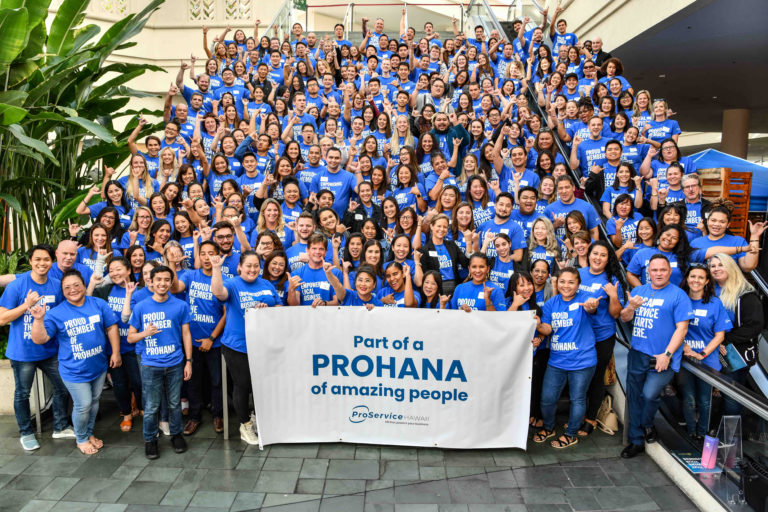
Talk to Sales!
Learn how ProService's HR solution can help your business
Let’s set up a time to chat! Share your contact details and we’ll reach out to learn more about your business and answer any questions you have about our HR services.


